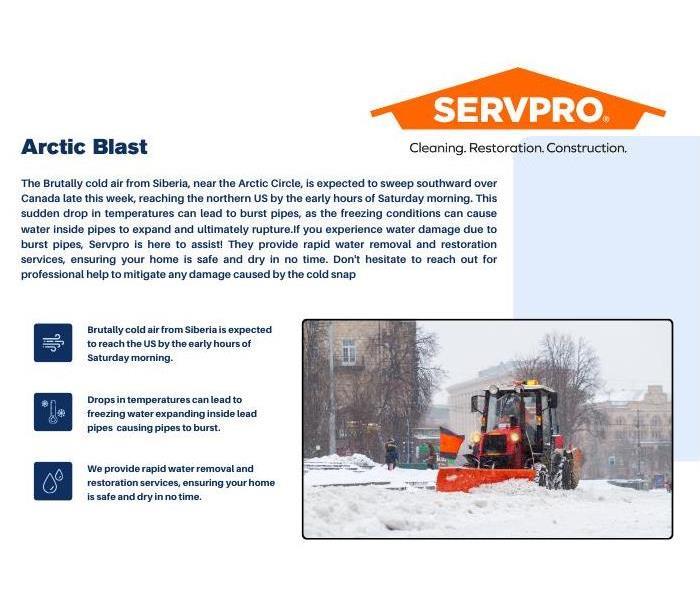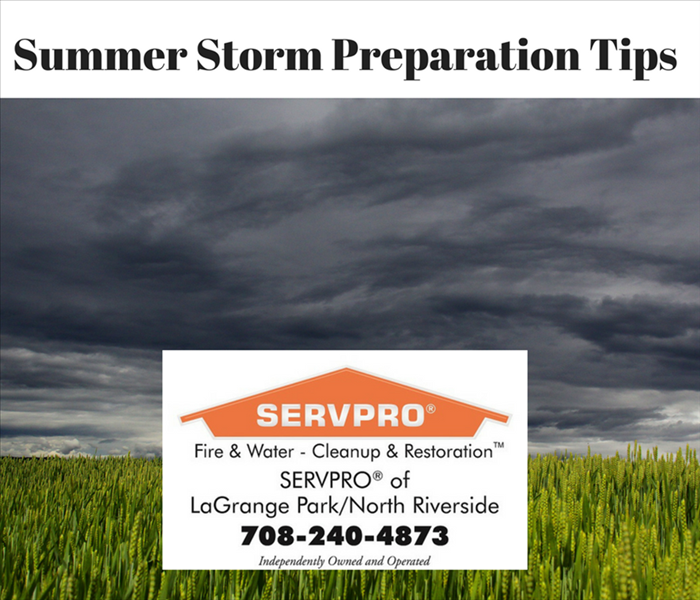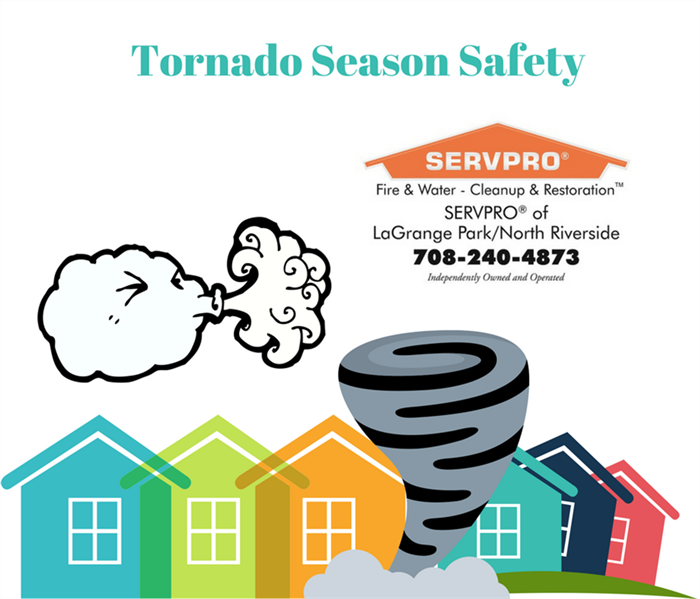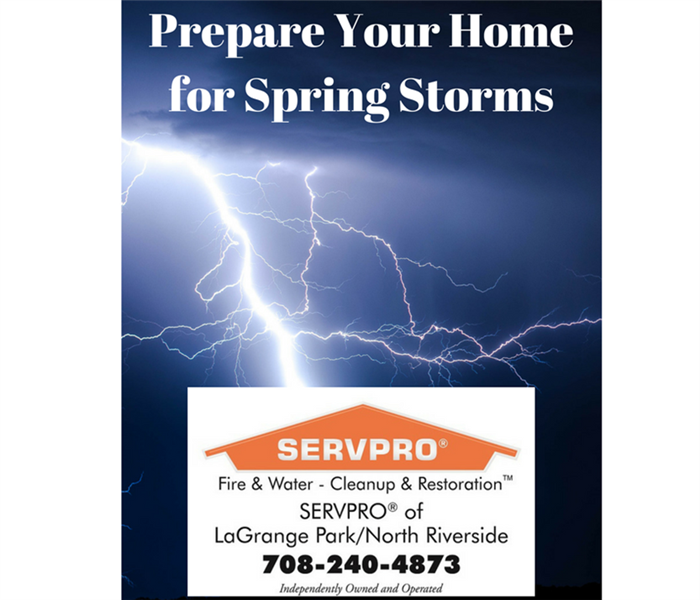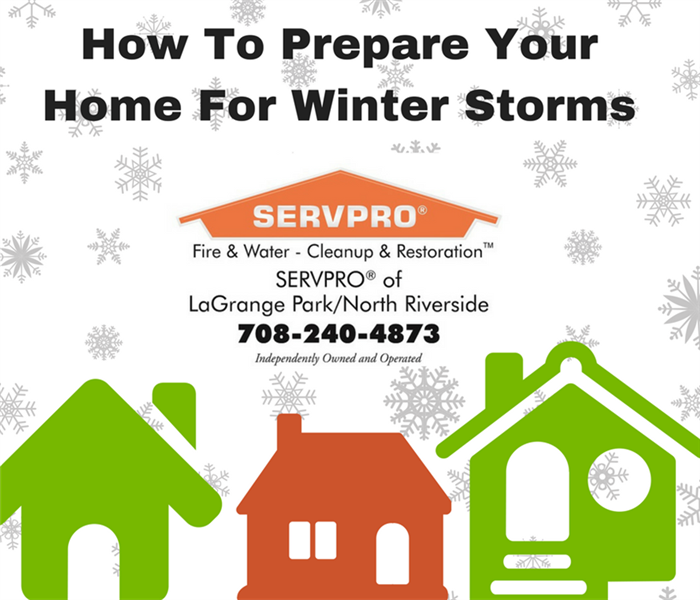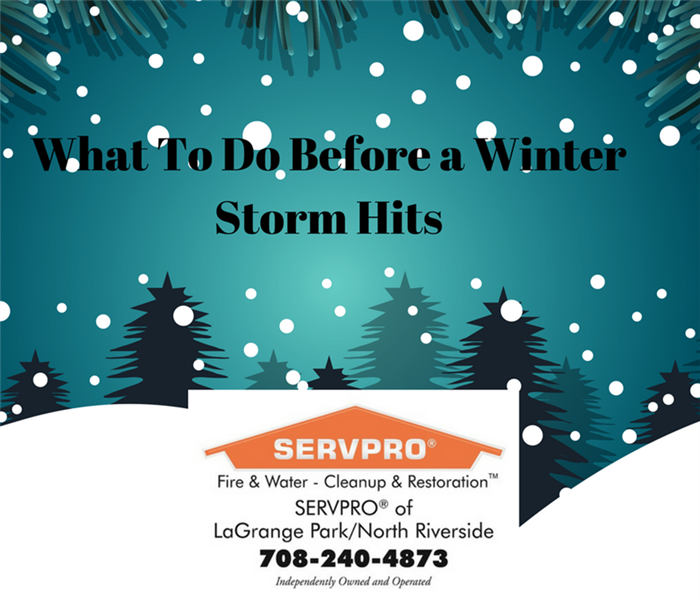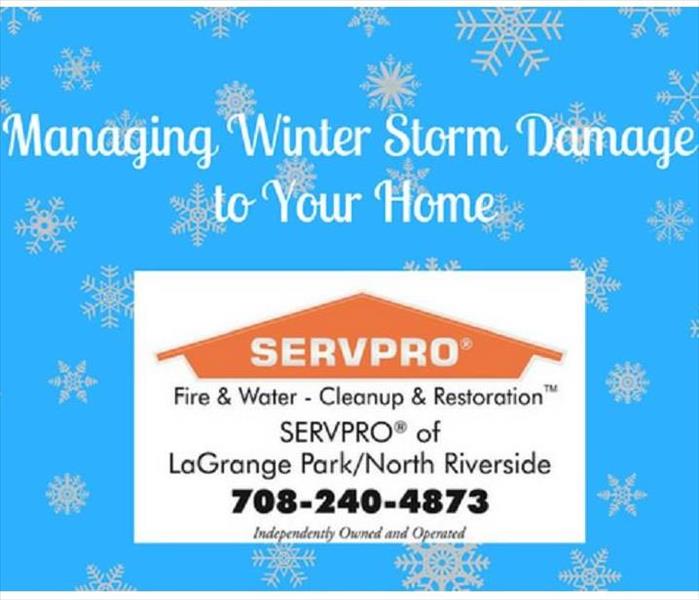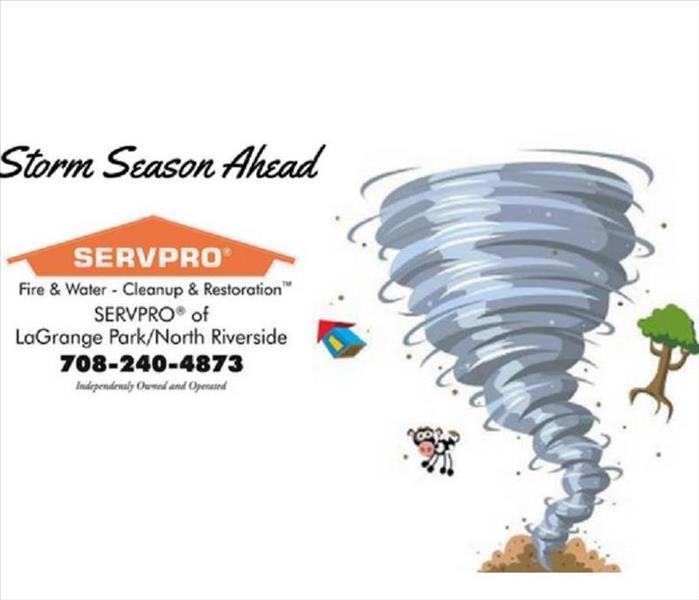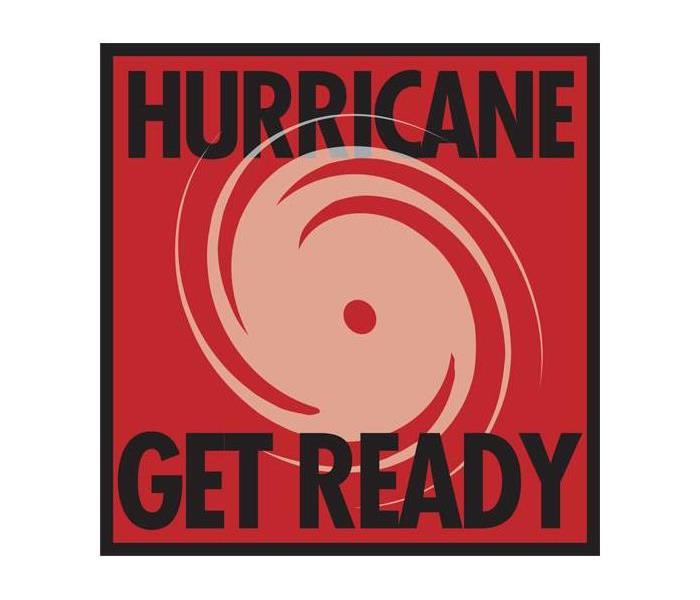Archived Storm Damage Blog Posts
Expected Arctic Blast
1/16/2025 (Permalink)
Weather Forecast Update
Brutally cold air from Siberia, near the Arctic Circle, is expected to sweep southward over Canada late this week, reaching the northern US by the early hours of Saturday morning.
Potential Impact
This sudden drop in temperatures can lead to burst pipes, as the freezing conditions can cause water inside pipes to expand and ultimately rupture.
How SERVPRO Can Help
If you experience water damage due to burst pipes, SERVPRO is here to assist! They provide rapid water removal and restoration services, ensuring your home is safe and dry in no time. Don't hesitate to reach out for professional help to mitigate any damage caused by the cold snap!
Preparing for Winter: The El Niño Storm and Weather Predictions near Chicago
10/10/2023 (Permalink)
As winter approaches, it's important for homeowners and businesses to be aware of potential weather patterns and prepare accordingly. One significant factor that can influence winter weather is the El Niño phenomenon. In this blog post, we, at SERVPRO®, will delve into the concept of El Niño, its impact on weather patterns near Chicago, and provide valuable tips on how to prepare for the upcoming winter season.
Understanding El Niño: El Niño refers to the warming of the ocean waters in the central and eastern parts of the Pacific Ocean. This climatic event occurs irregularly every few years and can have a profound influence on global weather patterns. During an El Niño event, the jet stream shifts, often resulting in milder and wetter conditions in some regions, including the Midwest.
El Niño and Weather Predictions near Chicago: Based on weather predictions, the Chicago area is likely to experience an above-average winter precipitation due to the El Niño effect. This means that residents should prepare for increased snowfall and potentially higher chances of freezing rain or sleet. With this in mind, it's crucial to take proactive steps to protect your property and ensure the safety of yourself and others.
Preparing for Winter in the Face of El Niño:
Winterize Your Property: Inspect and seal any gaps or cracks in windows, doors, and walls to prevent drafts and heat loss. Insulate pipes to prevent freezing and potential water damage.
Clear Gutters and Drains: Ensure that gutters and drains are clear of debris to prevent water buildup and ice dams. Regularly clear snow from roofs and remove any icicles to prevent potential structural damage.
Stock Up on Winter Supplies: Have an ample supply of rock salt or ice melt on hand to prevent slips and falls on icy surfaces. Stock up on emergency supplies such as flashlights, batteries, and non-perishable food items in case of power outages.
Maintain Heating Systems: Schedule a professional inspection of your heating system to ensure it is in proper working condition. Regularly replace furnace filters and consider investing in a programmable thermostat to optimize energy usage.
Prepare for Water Damage: In the event of excessive snow or freezing rain, be prepared for potential water damage. Keep SERVPRO's contact information handy to quickly address any water-related emergencies or flooding that may occur.
Conclusion: As we brace ourselves for winter near Chicago, it's essential to stay informed about the potential impact of the El Niño storm. By taking proactive measures to winterize your property, clear gutters, and stock up on supplies, you can effectively prepare for the challenges that come with increased winter precipitation. Remember, SERVPRO is here to assist you with any water or storm-related emergencies that may arise.
Stay safe, stay prepared, and embrace the beauty of the winter season!
Best regards,
The SERVPRO Team
Central Illinois and surrounding areas are flooded by storms.
8/4/2022 (Permalink)
Severe storms have been traveling through Central Illinois and Missouri recking havoc on residents leaving hundreds homeless or displaced with flood damage. Historic rainfall began July 25th, 2022 shattering a the 100 year old record. Additional rain and isolated thunderstorms continue to threaten the St. Louis and central Illinois area. Mayor Tishaura Jones declared the city in a state of emergency which should help gain resources the city needs for recovery.
These severe storms and rainfall cause a significant amount of property damage. Luckily, However SERVPRO is on the case. There have been over 30 franchises and 90 crews dispatched on-site in the Illinois and Missouri areas. SERVPRO franchises have traveled from as far a 7-8 hours gaining help from surrounding midwestern franchises. We are all-hands-on-deck in helping the over 2000 new calls for help.
Our highly trained Disaster Recovery Team specializes in property damage restoration, water damage restoration and fire damage restoration. Our team utilizes advanced technologies alongside The Institute of Inspection’s cleaning and restoration industry standards to provide exceptional service. We believe in continuous training from initial and on-going training at SERVPRO’s corporate training facility to regular IICRC industry certifications. Rest assured our staff is equipped for any of your clean-up, restoration, and construction needs.
References:
Woytus, A. (2022, July 26). Historic rainfall in St. Louis shatters 100-year-old record. St. Louis Magazine. Retrieved August 4, 2022, from https://www.stlmag.com/news/historic-rainfall-st-louis-floods/
Hays, G. (2022, July 28). Historic rainfall in St. Louis raises questions about flooding and climate change. PBS NewsHour. Retrieved April 8, 2022, from https://www.pbs.org/newshour/nation/historic-rainfall-in-st-louis-raises-questions-about-flooding-and-climate-change
Residents of Illinois are in a state of emergency as a result of the supercell storm as they battle storm damage, flooding, and dangerous heat waves.
6/17/2022 (Permalink)
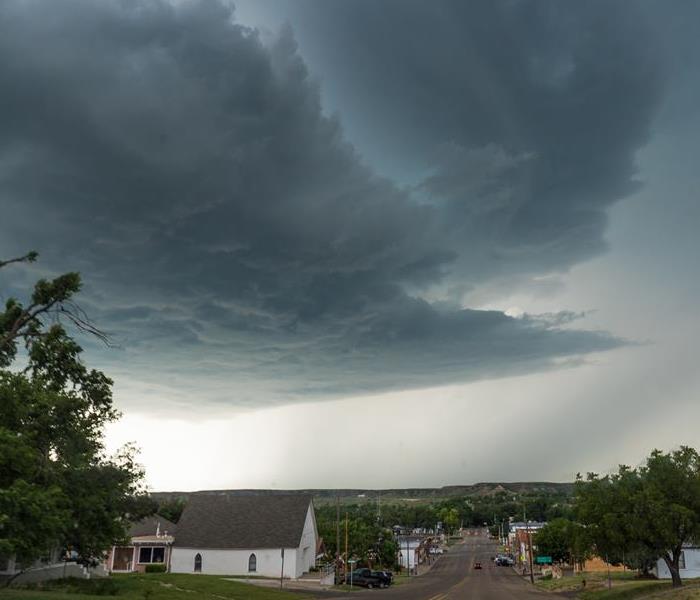 Photo of Supercell
Photo of Supercell
The streets of Broadview and neighboring areas are littered with debris, branches, and uprooted trees. Monday’s supercell storm rampaged throughout Illinois suburban area’s, leaving residents to battle dangerous heat levels without power. As temperatures increase Cooling stations are placed through the area as ComEd rushes to restore power powerlines destroyed by downed trees during the storm.
Mayor Katrina Thompson and Mayor Andre F. Harvey declare a local state of emergency for Broadview and Bellwood. Public works and contractor crews are addressing the debris, branches and uprooted trees caused by the storm. However, as stated by Mayor Katrina Thompson “Clean-up is going to be expensive for residents, businesses, and the Village of Broadview alike, so the official emergency declaration will make our community eligible for financial assistance to aid our recovery.” As volunteers of Home Depot, Cook County Government, and ComEd worked together to clear up the debris the mayor lifts permits for roofs, fences, and tree removal.
Outages also extend to La Grange Park where tension continues to grow between the La grange Country Club and the village officials. Last year after only a couple of being in office former Village Board Trustee Mikes Matteucci resigned due to this conflict of interest as a member of the country club. Many attempts from the village officials have seemed to fall on deaf ears such as the Village Board Meeting invitation to discuss stormwater issuing in which the Club did not participate. All while the trial to settle disputes between La Grange and a nearby quarry have been delayed. The trial set for July 18th has been pushed back to September 19th possibly to give time for the Hanson Aggregates quarry to implement its expert’s recommendations to expand its drainage ponds. It is said that this dispute derives from the Quarry cutting a drainage pipe three decades ago.
Let’s all continue to hope that the village and its residents reach some sort of resolution as flooding continues to become a growing problem. These are our neighborhoods so let’s put our heads together to find the best outlook for our towns and villages.
Sources:
Rezaei, A., & Barack, M. (2022, June 16). Residents in suburban Broadview battle dangerous heat; still without power following Monday’s storms. CBS News. Retrieved June 17, 2022, from https://www.cbsnews.com/chicago/news/suburban-broadview-heat-still-without-power/
Giuliani, D. (2022, June 15). Country Club Confuses La Grange On Flooding: Official. La Grange, IL Patch. Retrieved June 17, 2022, from https://patch.com/illinois/lagrange/country-club-confuses-la-grange-flooding-official
Giuliani, D. (2022b, June 15). Outages Remain In La Grange Park: Village. La Grange, IL Patch. Retrieved June 17, 2022, from https://patch.com/illinois/lagrange/outages-remain-la-grange-park-village
Giuliani, D. (2022a, June 14). La Grange Flooding Trial Delayed 2 Months. La Grange, IL Patch. Retrieved June 17, 2022, from https://patch.com/illinois/lagrange/la-grange-flooding-trial-delayed-2-months
Conditions of Extreme Weather
5/23/2022 (Permalink)
Severe weather forecasts are expected for the next couple of days in Texas, and Oklahoma, and will stretch to the southeast and possibly the upper Midwest area. Rain and flash flooding will be a strong concern. Major moisture coming from the Golf will make for heavy downpours of rain. This comes with good concern after pre-monsoon deluges have flooded parts of India and Bangladesh killing two dozen people and leaving about 90,000 others homeless. the Indian Army and Air Force have evacuated thousands in the past 2 weeks across the border in Bangladesh officials said at least 3 rivers are in danger of overflowing crop fields have been damaged and hundreds of villages are without clean water supply as flooding overtopped wells and damage supplies extreme weather events are becoming more common in South Asia due to climate change this bout of heavy rain is happening early monsoon season usually does not start until early June in the region. SERVPRO of La Grange Park is able to, upon request, service the Chicago metropolitan area in northeastern Illinois, including Chicago and its surrounding suburbs. So for your flooding and water damage concerns please contact SERVPRO of La Grange Park.
The Associated Press. (2022, May 23). Heavy rain floods parts of India, Bangladesh. ABC News. Retrieved May 23, 2022, from https://abcnews.go.com/International/wireStory/deluges-rain-flood-parts-india-bangladesh-84904733
Davis, D. D. (2022, May 23). Dozens Killed, Thousands Displaced in India and Bangladesh Flooding - Videos from The Weather Channel | weather.com. The Weather Channel. Retrieved May 23, 2022, from https://weather.com/news/weather/video/dozens-killed-thousands-displaced-in-india-and-bangladesh-flooding
Be Prepared for the Next Winter Storm With These Tips!
1/6/2022 (Permalink)
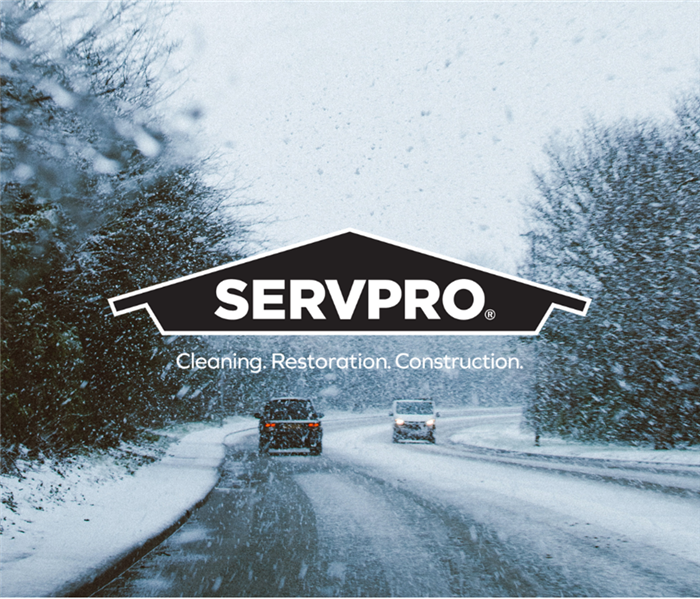 Before the next winter storm arrives, get your car's antifreeze levels, battery, ignition system, exhaust system, heater, lights, and oil checked.
Before the next winter storm arrives, get your car's antifreeze levels, battery, ignition system, exhaust system, heater, lights, and oil checked.
Winter storms can bring not only a lot of snow, but also bitterly cold temperatures, strong gusts, freezing rain, and ice. They can bring down trees, make roads and pathways extremely unsafe, and produce power outages that linger for days. Schools and daycare facilities may be closed as a result of the disruption to public transit. Winter storms also increase the likelihood of car accidents, hypothermia, frostbite, carbon monoxide poisoning, and heart attacks.
That's why, with winter storm season in full swing, knowing how to protect yourself, your family, and your house safe is essential.
Here are some things you can do now to prepare for the impending storm.
1. Make sure you have enough food in your pantry.
Because it's critical to stay indoors and avoid traveling during a winter storm, making sure you're well-stocked on food is critical. Many non-perishable things should be in your pantry so that you don't have to worry about anything deteriorating if you lose electricity. Ideally, you should have enough food to last at least three days.
2. Buy Bottled Water
Make sure you have plenty of bottled water on hand in case your pipes freeze and you can't get water from the tap. You may also require water for brushing your teeth, cleaning dishes, flushing toilets, or bathing if your pipes freeze. You can also prepare ahead of time by filling the bathtub, jugs, bottles, and other containers with water.
3. Get your prescriptions filled and hygiene items picked up
Make sure all of your prescription drug prescriptions are filled so that you have enough on hand to last at least three days, if not a week. This eliminates the need to rush to the pharmacy when the roads are poor.
You should also stock up on any hygiene products you may require, like as diapers, toilet paper, tampons, and toothpaste. Picking up moist toilet paper can also be beneficial if water is scarce.
4. Check your tools and stock up on ice melt.
Ice melt salt sells out quickly in local stores just before a storm, so start buying up early to ensure you have enough for after the storm. You'll need enough to shovel and salt all of your outside stairs, stoops, and walkways immediately following the storm, before the snow melts and turns to ice as the temperature drops.
Before the storm hits, make sure you have a good snow shovel (or two). Make sure they aren't too worn or cracked, as this will only complicate your life. You'll also want to make sure your tool kit is up to date and simple to locate, since you may need a wrench or pliers to quickly turn off utilities.
5. Be Prepared For A Power Outage
Charge your cell phones in advance of the storm, and have some portable battery backups available in case the power goes out. It's also a good idea to keep flashlights or battery-powered lights around the house so you don't have to waste time looking for them.
If you live in a region where power outages are common, you should consider purchasing a generator, either a portable or a standby one for your home. If you have a portable generator, make sure you have enough gasoline or propane before the storm to operate it whenever and for as long as you need it. Always use portable models outside, away from windows, and never use them indoors or in confined locations like garages, crawl spaces, or basements.
6. Take Care of Your Water Pipes
Allow cold water to flow from faucets supplied by exposed pipes to help prevent frozen pipes. Running water, even at a trickle, is less likely to freeze. Allow warm air to circulate near plumbing by opening cabinet doors in the kitchen and bathroom. Pipe insulation should be added to any pipes that are prone to freezing. Maintain a temperature of no less than 55 degrees Fahrenheit inside your home.
7. Make sure your windows and doors are well-sealed.
Drafty windows and doors let chilly air in while letting warm air out. That's why it's a good idea to use an insulation kit from any hardware shop to seal any windows. Weatherstripping can also be purchased at the store to improve the seal on your front door.
Insulated blinds are also available to help keep the warm air inside the house.
8. Inspect and replace smoke and carbon monoxide detectors if necessary.
Make that your smoke and carbon monoxide alarms are still operational. It's advisable to replace them with detectors that work during a power outage if they aren't already battery-powered or battery-backed to keep your family safe.
9. Get Your Backyard Ready
Take a trip around your yard before the storm to check for any tree limbs that could fall on your house. If you have the ability, you should prune those back to prevent them from causing damage to your property during the storm – or hire someone to do it for you.
If any tree branches are near power lines, you should get them trimmed or chopped back by a professional or the utility to assist reduce the danger of a power outage.
Mulch your gardens, if you haven't already, to protect plants that you don't want to freeze.
10. Get Your Car Ready
Before the next winter storm arrives, get your car's antifreeze levels, battery, ignition system, exhaust system, heater, lights, and oil checked.
Then, in case you're trapped in your automobile due to the blizzard, prepare your car with items you might require. Blankets, water, chains, jumper cables, ice scrapers, maps, bottle water, warm clothing, non-perishable snacks, and a first-aid kit should all be in your car. It's also a good idea to have some sand or kitty litter on hand in case you get stranded in the snow or ice.
11. Keep yourself up to date
Listen to your NOAA weather radio for hazardous weather alerts and warnings. Always keep an eye on the weather forecast, whether it's on the internet or on your phone. Sign up for emergency alerts and updates in your area.
In the event of an emergency, know how to cut off your utilities, such as gas lines.
Before the storm strikes, do some research on nearby shelters and warming centers, and establish a plan for where to go and how to get there if you need to leave your house in an emergency.
Also, be aware of the symptoms of hypothermia and frostbite, and be prepared to check on your neighbors, particularly if they are elderly or have young children who are more vulnerable to the cold.
Here's What You Need in Your Winter Car Emergency Kit if You Get Stranded in a Snow Storm
12/1/2021 (Permalink)
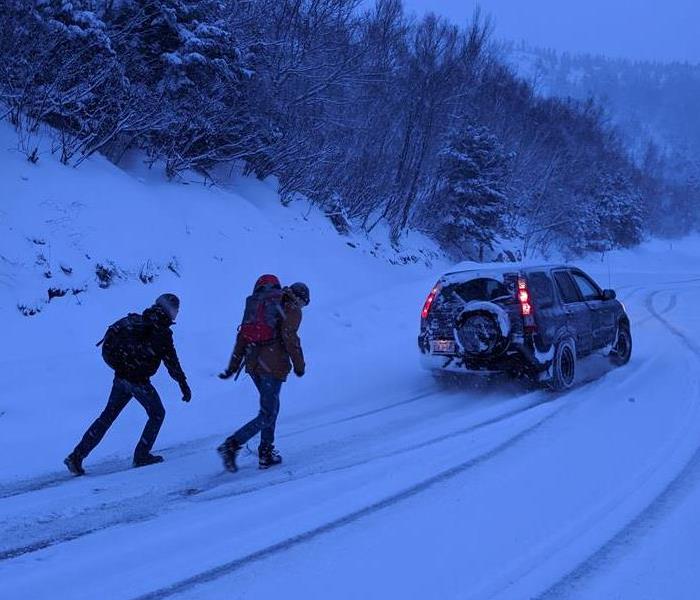 Winter Car Emergency Kit
Winter Car Emergency Kit
For the drivers in your family, including yourself, a winter car emergency kit is a must-have. Winter weather may leave you stranded, but having a well-stocked emergency pack can help you get back on the road, or at the very least make the time you wait for help safer and more comfortable.
- Booster cables for batteries. You'll need these if you have a dead battery or if you need to assist someone who has a dead battery. A portable jump starter, on the other hand, is simple to use and effective, but it must be kept charged while on the road.
- Ice scraper. In the snowbelt, every car should have an ice scraper and a brush. Scrapers are usually included in the kits for a low cost. It is preferable to include a snow brush/scraper that makes cleaning snow prior to travel much easier. It is the law in several areas to clear your automobile of all snow. Even if it isn't, it's just good manners to keep your blowing snow from obstructing another driver's eyesight.
- Portable Shovel. These are useful for digging out a car that has been buried by plows or stranded by the side of the road, as well as creating space around a tailpipe for lengthy idling to avoid pollutants from entering the vehicle. A collapsible shovel is included in most kits. (The shovels are available in various sizes and strengths.) If you've ever had to dig your car out, a full-sized shovel may be necessary, as tiny shovels can be tough to handle on larger operations. Additionally, have a bag of sand in your trunk to aid traction.
- Handy Items. The majority of kits feature a flashlight, and some also include a warning cone to alert approaching traffic of your presence. For that flashlight, bring extra batteries. Roadside triangles should be included in every pack, and some come with a reflective safety vest.
- A basic first-aid kit. Most emergency kits include a section for the minimal necessities, such as bandaging a tiny cut. Add items that are unique to your health needs, and keep in mind how temperature can alter medications.
- Charger for cell phone. A cell phone charger is a useful thing to keep in the car, especially during the winter and on road trips, because almost everyone nowadays has a smartphone hooked to their hip.
- Other items that are common. Gloves, a blanket, a rain poncho, wipes, and rags can all help you stay clean while also protecting you from the weather. Keeping a pair of boots and a cap in the car is a good idea, especially if you frequently drive in icy conditions.
- Strap for towing. A strap is a simple item that can be quite useful if you ever need to be hauled out of a ditch. Before you use the strap, make sure you know how much weight it can tow (reliable straps will have that information printed on the label) and how to tie it to the proper portion of the automobile. Read your car's owner's manual for tips on how to use a tow strap, such as how to utilize a detachable tow hook with a tether.
- A fire extinguisher. It's useful if you need to put out a little fire, but if your automobile is on fire, back off and call for help. If you buy a fire extinguisher, check sure it's designed for use in cars.
- Items to deal with a flat tire. Some kits include an aerosol can of tire sealant that can be used to temporarily repair a punctured tread. These products are not intended for big punctures or tires with sidewall damage, and they may not perform effectively in extremely cold conditions (see the directions). If a spare tire is available, use it, or ask for a tow from roadside help.
What do you have in your car emergency kit?
How to Stay Safe During a Wind Storm!!
11/1/2021 (Permalink)
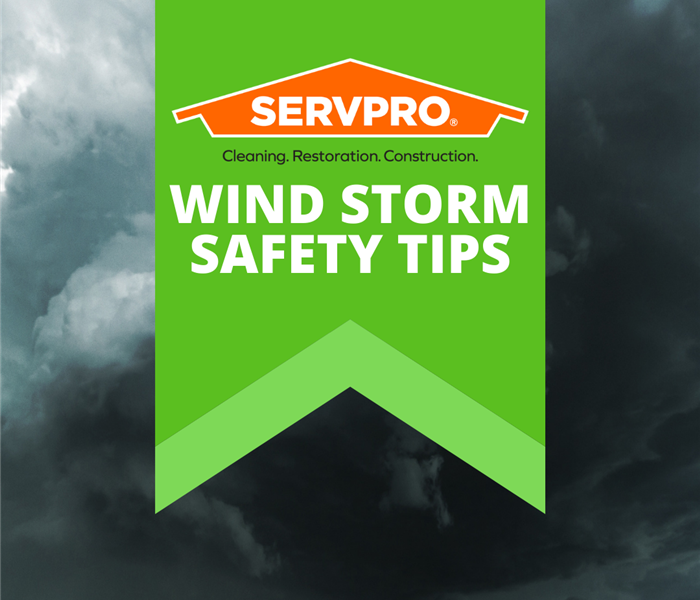 Tips to stay from wind storms
Tips to stay from wind storms
Winds can reach speeds of more than 100 miles per hour during extreme weather events such as tornadoes!
High winds of any speed, on the other hand, can cause damage to homes and property, as well as flying debris and shattered glass, which can cause injuries. A disaster preparedness plan for your family, including a disaster survival kit and an emergency evacuation plan, can save your family from injury and inconveniences.
Keep yourself updated!
Weather updates and advisories will be broadcast on the radio and television. Having the most up-to-date information is critical to keeping safe during a weather event. For updates, utilize an NOAA Weather Radio or battery-powered radio, and keep an eye out for mobile alerts.
A high wind alert indicates that persistent winds of more than 25 mph are expected.
Warnings for thunderstorms and tornadoes should be taken seriously since they indicate that severe weather has been detected and is on its way.
During bad weather, seek cover!
- Remove yourself from windows and glass doors and into the center of your house or basement. Take refuge under a stairwell or a large piece of furniture.
- During heavy winds, do not stay in a mobile home. High winds can easily topple them, and flying debris can penetrate their light frames and exteriors.
- Make a safe room for yourself. If you live in a location where violent winds are common, you should consider constructing a safe room in your home.
Protect your home against extreme weather and wind events with these helpful tips
- Vehicles that you want to leave behind should be parked or stored in a garage. If you don't have a garage, relocate your belongings to higher ground in the event of flooding.
- Garbage cans, patio furniture, barbecues, and other potentially wind-borne items should all be kept inside your house or garage.
- Close the doors and windows to your home. In the event of severe winds, board up windows and glass doors with shutters or plywood to prevent harm from broken glass.
- Secure your outdoor pool and turn it off. To avoid damage, turn off the circuit breaker for your outdoor pool and remove the engine.
- Tree branches that pose a danger should be removed. Pruning branches that may break off during a storm and injure someone or cause damage to your home or vehicles is a good idea.
- A generator can be rented or purchased. A generator can assist keep refrigerators, freezers, and lights running if you can rent or buy one. A severe storm can knock out power for days, if not weeks, at your home.
- Keep an ear out for weather updates on the radio. If you are told to evacuate, follow local officials' instructions and head to a shelter.
- Let your friends and family know where you'll be.
If you don't have time to get to a shelter, go to your safe room if you have one. Otherwise, stay in the center of your house or basement, away from windows, and hide under a stairwell or a large piece of furniture.
When storms or floods hit La Grange/N. Riverside, SERVPRO is ready!
9/27/2021 (Permalink)
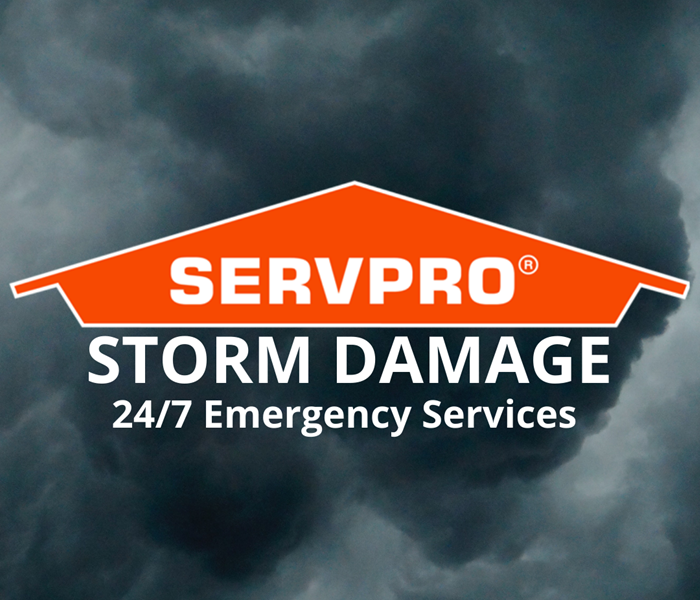 24/7 Storm Damage Emergency Service
24/7 Storm Damage Emergency Service
The effects of a storm or a flood can be catastrophic! You need to act quickly, and you need a professional that has experience with storm damage. SERVPRO La Grange/N. Riverside Professionals have the training, equipment, and resources to manage any major disaster and can respond quickly to storm and flooding situations.
What do we provide?
- 24 hour Emergency Service
- Highly Trained Water Damage Specialists
- Resources to Handle Storms and Disasters
Regardless of the Storm Damage, We Can Help!
SERVPRO of La Grange/N. Riverside can handle any size disaster, regardless of the type of storm. Our Disaster Recovery Team can respond rapidly with additional resources during major storms and disasters.
- Flooding caused by heavy rains
- Tornadoes and wind damage
- Ice and snowstorms
Have storm or flood damage? Call us at (708) 240-4873!
Hurricane Season 2021
9/13/2021 (Permalink)
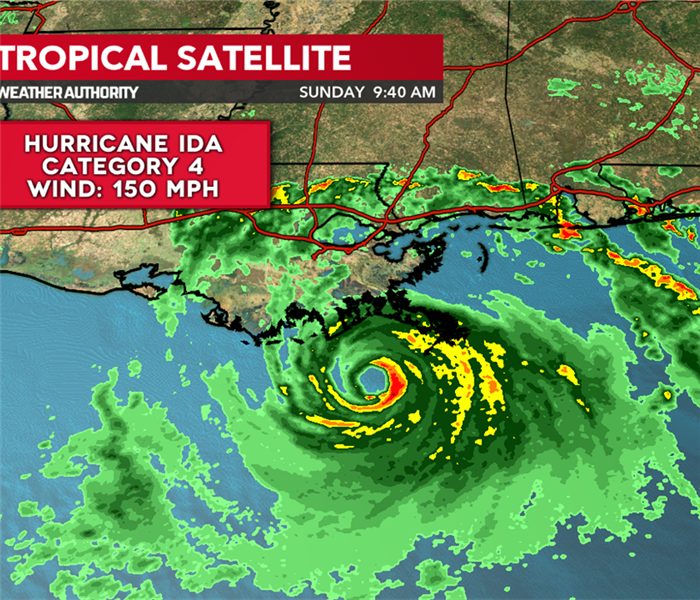 Have a plan and be prepared!
Have a plan and be prepared!
Hurricane season is upon us! Experts say that the hurricane season starts in May and lasts all the way until November on average. Each year is different. However, as on Friday September 10th, it has officially marked its peak of hurricane season for the Atlantic Basin. We have seen during this year there has been 13 named storms, and 5 of those reached a hurricane status and 3 of which became major hurricanes. Here is a list of the 13 hurricanes so far..
1. Ana: Formed near Bermuda on May 22nd
2. Bill: Formed off the East Coast on June 14th
3. Claudette: Formed in the northern Gulf of Mexico June 19th
4. Danny: Formed along the East Coast near Charleston, South Carolina on June 28th
5. Elsa: Formed in the central tropical Atlantic on July 1st
6. Fred: Formed in the eastern Caribbean on August 10th
7. Grace: Formed in the central tropical Atlantic on August 14th
8. Henri: Formed near Bermuda on August 16th
9. Ida: Formed south of Jamaica in the Caribbean on August 26th
10. Julian: Formed far out in the Atlantic on August 29th
11. Kate: Formed in the central, open Atlantic on August 30th
12. Larry: Formed in the far eastern Atlantic on September 1st
13. Mindy: Formed in the northeaster Gulf of Mexico on September 8th
With the knowledge of knowing we have officially hit the peak of hurricane season, here are some tips on how to be prepared for a hurricane in your area.
- Make a plan: If evacuation is necessary, turn off all utilities and follow community disaster preparedness plans. Make sure you select a common meeting place for all family members. Also make sure you have an evacuation plan for your pets.
- Secure the exterior: Trim any large trees and shrubs. Bring in all outside patio furniture, potted plants, bikes and toys inside.
- Install storm shutters: These will protect your windows, doors and skylights with appropriate shutters or impact-resistant glass.
- Check wall hangings and art: Make sure all wall hangings are secure and take notes about your art collection and any existing damage.
- Move your cars: Keep your cars to higher ground or park them in your garage against the garage doors.
- Power up: Fill up your car's gas tank, make sure all cell phones are fully charged, test your generator and always have plenty of fuel ready in case the power goes out.
- Store important documents: Make sure to keep important documents, such as legal papers, birth certificates, marriage license, insurance policy information, and any valuables in a safety deposit box in the closet of your home.
- Prep an emergency kit: You will need to gather any flashlights, portable radio, batteries, non-perishable food, bottled water, cash, blankets, toiletries and clothing.
- Identify a shelter room: This area should be on the first floor in the central part of the house that has no windows.
We here at SERVPRO understand that when disaster strikes, you don't know what will be left from the aftermath. We are always here to help with any mitigation or reconstruction services you may need!
Tornado Watch: BE PREPARED!
8/9/2021 (Permalink)
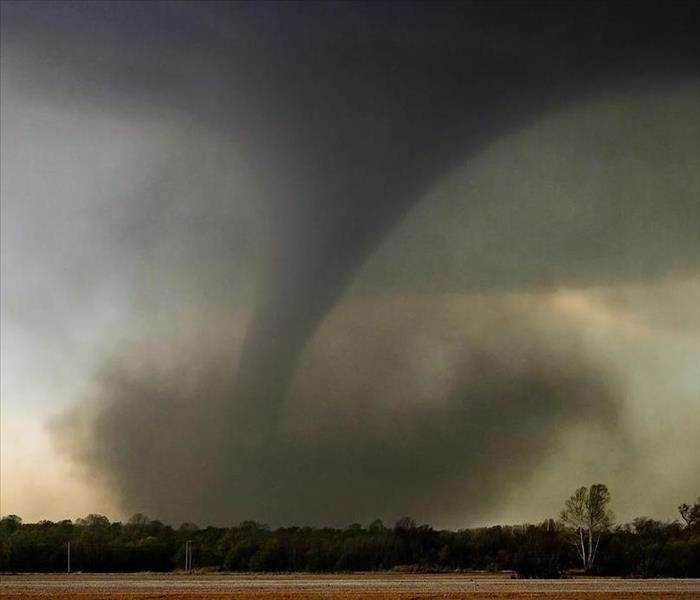 Have a plan!
Have a plan!
There has been ANOTHER tornado watch that has been issued for northern Illinois throughout the afternoon and evening. The watch has been issued until 10PM tonight for over 17 counties in Illinois. Severe storms are possible across northern Illinois and northwest Indiana. There is an area-wide threat for damaging winds, large hail and a couple tornadoes. There will also be heavy rainfall and flooding that can go into overnight. The weather service advises having multiple ways to receive weather warnings. They are also suggesting to have a plan set in place with your family and friends.
When it comes to making a plan for when disaster strikes, it is important to know which types of disasters could affect your area. Make sure to know how you will contact one another and reconnect if separated. Establish a family meeting place that's familiar and easy to find. Make sure to have the following..
1. A way to receive emergency alerts and warnings
2. Shelter plan
3. Evacuation route
4. Family/household communication plan
5. Update emergency preparedness kit
You will next want to consider specific needs in your household. Make sure to discuss your needs and responsibilities and how people in the network can assist each other with communication, care of children, business, pets or specific needs like operating medical equipment. Keep in mind some of these factors when developing your plan:
- different ages of members within your household
- responsibilities for assisting others
- locations frequented
- dietary needs
- medical needs including prescriptions and equipment
- disabilities or access and functional needs including devices and equipment
- languages spoken
- cultural and religious considerations
- pets or service animals
- households with school-aged children
You can never be to prepared when it comes to natural disasters, so please make sure you have a plan in place for when one strikes! Remember that SERVPRO is always here to help to make it look "Like it never even happened." Stay safe!
Chicagoland Winter Storms
1/7/2021 (Permalink)
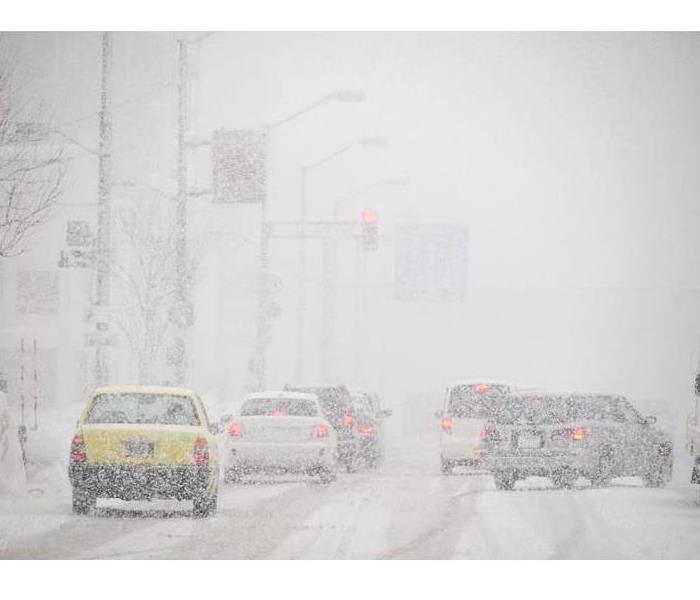 Be prepared!
Be prepared!
Protecting your home is vital in the winter months. A frozen water pipe can burst and flood your house. An ice dam in your gutter can cause water to seep into and saturate an interior walls of your home. Here is a list from Nationwide insurance that they advise their homeowners on during the winter months to prepare their homes for the cold.
- Clean out the gutters, disconnect and drain all outside hoses. If possible, shut off outside water valves.
- Insulate walls and attics, and caulk and weather-strip doors and windows.
- Repair roof leaks and remove tree branches that could get weighed down with ice or snow and fall on your house – or your neighbor's. (Avoid liability for the latter.)
- Wrap water pipes in your basement or crawl spaces with insulation sleeves to slow heat transfer.
- Consider an insulated blanket for your hot water heater.
- If you have a fireplace, keep the flue closed when you're not using it.
- Have a contractor check your roof to see if it would sustain the weight of a heavy snowfall.
- Make sure your furniture isn't blocking your home’s heating vents.
- During cold spells, keep cabinet doors open to allow warm air to circulate around pipes, particularly those in the kitchen and bathrooms.
- Keep a slow trickle of water flowing through faucets connected to pipes that run through unheated or unprotected spaces.
- If your house will be unattended during cold periods, consider draining the water system.
- Avoid ice dams– where water from melted snow refreezes in the gutters and seeps in under the roof, soaking interior walls. Here’s how:
- Ventilate your attic.
- Insulate the attic floor well to minimize the amount of heat rising through the attic from within the house.
- Consider having a water-repellent membrane installed under your roof covering.
If you do find that you have damage to your home, the Insurance Information Institute has published some tips on what to do in the case of a winter storm and managing the damage to your home.
- Take pictures of the damage immediately. If you have "before" pictures, that's even better. Those pictures will help ensure that your insurer cannot claim that the problem was preexisting.
- Make temporary repairs to keep the damage from getting worse but hold on to all of your receipts.
- Don't make pricey repairs before the insurance adjuster arrives.
- Don't assume something is not covered. Take out your policy. Most weather-related damage like burst pipes, a collapsed roof and ice dams are covered.
- Call a reputable company to come and help with any damages to your home. Choose a company that will work with your insurance company.
SERVPRO of LaGrange Park/North Riverside is here to help in your time of need for all your winter storm damage needs. Give us a call at 708-240-4873. We work with your insurance companies to make it “Like it never even happened.”
STORMS IN THE AREA
12/1/2020 (Permalink)
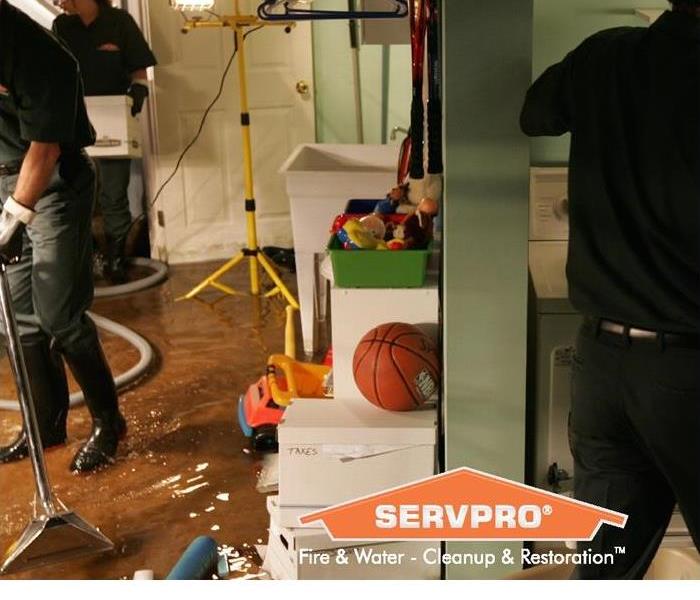 We are here 708-240-4873!
We are here 708-240-4873!
Recover - part 3 of 3
Once floodwaters have cleared, it's time to recover and rebuild. We Have the Resources to Handle Storms and Disasters.
In addition to our own resources, we can access equipment and personnel from over 1,700 Franchises across the state and country. We can even call upon strategically located Disaster Recovery Teams for catastrophic storms and major events.
What you did and didn't know about tornadoes
11/3/2020 (Permalink)
The Websters Dictionary defines a tornado : "A tornado is as a rotating, funnel-shaped cloud that extends from a thunderstorm to the ground with whirling winds that can reach 300 mph. Damage paths of tornadoes can be in excess of one mile wide and 50 miles long."
According to the study done by The Weather Channel. Each year in the U.S., 1,200 tornadoes on average kill 60 people, injure 1,500, and cause roughly $400 million in damages, putting long-term average tornado losses on par with hurricanes.
There are many misconceptions in regards to tornadoes. Here are some facts from tornadofacts.net
Tornado Safety Related Myths
- Southwest corner of your home/building/shelter is the safest location - In 1887 John P. Finley wrote a book on his observations of his tornado research. While he published some ground breaking information on tornadoes he also helped created this tornadoes myth. John believed that tornadoes only traveled in a northeast direction and that derby they created would be carried in the direction of its propagation. The 1997 F5 Jarrell tornado is a prime example of his misconceptions since that tornado moved in a south-southwesterly direction. It's recommended that you always seek shelter in the lowest floor of a building, preferably under an I-beam or staircase, regardless of the type of building you're in.
- Open all the windows in your home when a tornado warning is issued - This is an extremely dangerous myth because it takes away critical minutes that could be used to reach shelter. It used to be widely believed that you needed to open your windows during a tornado to equalize pressure and prevent your house from exploding. A violent tornado will only have a 10% drop in pressure which isn't anywhere near enough to cause your home to explode. Ignore your windows and seek shelter immediately when a tornado warning is issued.
- A highway overpass is an excellent tornado shelter - This myth gained huge traction in 1991 when a TV crew survived a tornado unharmed by sheltering under a overpass in El Dorado, KS. This event had nationwide coverage with video of the event and that helped perpetuate this myth to a dangerously high status. The conclusion for scientific evidence from the Oklahoma outbreak in 1999 actual proved that overpasses are actually one of the worst places to seek shelter during a violent tornado; mostly due to the wind tunnel effect that can accelerate flying derby speed even during weak tornadoes.
- You can outrun a tornado via a vehicle - The theory behind this myth is a vehicle can travel faster than the average tornado, but the key phrase is average. There is no way for someone to know the travel and wind speed of a tornado just by looking at it. Plus the flooding, hail, and flying derby from a tornado can put someone in a vehicle in danger. The official directive from the National Weather Service is if you spot a tornado nearby to abandon your vehicle and seek shelter in a nearby building, culvert or ditch.
- A brick or stone building can protect me from a tornado - While a brick or stone building can provide better protection during tornado a violent only can easily turn a brick or stone building into a pile of rubble. It's recommended that you always seek shelter in the lowest floor of a building, preferably under an I-beam or staircase, regardless of the type of building you're in.
- If a tornado isn't coming directly towards me I'm safe - In the past it was common belief that a tornado would only travel in a northeasterly direction. While it's true that most tornadoes will move northeast this is most due to the direction the storm is traveling. Tornadoes are erratic, unpredictable, and can come from any direction. A prime example is the 1997 F5 tornadoes that struck Jarrell, TX which traveled southwest.
When a major storm hits, it may overwhelm local restoration companies. SERVPRO of La Grange Park / North Riverside can scale our resources by accessing the equipment and personnel of 1,700 Franchises. We can also access Disaster Recovery Teams that specialize in major storms and catastrophic events.
FEMA!!
9/29/2020 (Permalink)
Some buildings are more at risk of flooding than others in Elmhurst, IL. The Federal Emergency Management Agency, or FEMA, aims to prepare every individual to handle any natural disaster that might affect him or her, and floods are no exception. There is a wealth of flood preparation knowledge you can find from this agency, including a flood risk map that shows you exactly how likely your home is to be affected by a flood. You should take the time to learn:
1. Which flood zone your home is located in
2. What flood insurance options you have
3. Where you fall on the flood insurance rate map or FIRM
4. The elevation of your property
5.What the evacuation plan is for your area
Flood Insurance
It is a good idea to have water damage covered by your insurance policy, but you may not realize that water damage and flooding damage is not the same thing. Water damage is caused by things like burst pipes or leaky roofs, but the damage caused by external factors like tidal waves or mudslides fall into a different category. Most people do not need flooding insurance, but if you are in a high-risk area, it might be beneficial. The National Flood Insurance Program, or FEMA NFIP, is a special program FEMA offers that provides affordable flooding damage insurance.
What To Do
FEMA also has recommendations for what to do during a flood. You should be intimately familiar with the evacuation plan in your area and have all the supplies you need before a flood happens. You should have plenty of canned food, bottled water, a first aid kit, and general tools. It might be good to have a flooding damage restoration company in Elmhurst, IL already in mind so you can start the process of repairing as soon as possible. Flood water contains contamination, so it is not safe to return to your home no matter how minor the damage is.
Storm Team- Iowa
9/1/2020 (Permalink)
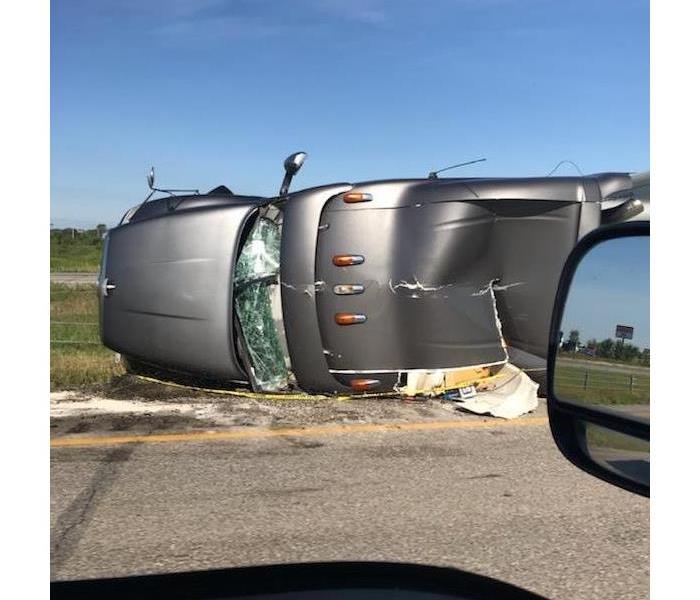 Our team helping fix the damages out in Iowa!
Our team helping fix the damages out in Iowa!
Over the past couple weeks, our storm team here at LaGrange Park/N. Riverside has been out assisting those who were hit with damage from the bad storm that went through Iowa. Our team has been working on a major project at one of the local hotels nearby. Our commercial large loss division is composed of the best of the best in restoration. Our commercial operations manager has been supervising the job every since we started down in Iowa. Our team was about to dispatch trained production professionals, and cut costs through the strategic placement and oversight of temporary labor. Once our team got word there was going to be a major storming rolling through there, we had a team ready to go the day before. After the storm hit, out team drove over 3 hours to get out to the location where the commercial property was. On the way, our team was able to see all the damage first hand driving through Iowa. Our team described it almost as a "scary scene in a movie". There was semi-trucks turned over on the highway, full grown trees pulled out of the ground, entire roofs taken off of homes, broken homes, and many more disasters that put tears to their eyes. Our team knew that they needed to help fix Iowa, and be able to make it strong again. To this very day, our team is still out in Iowa assisting the major commercial loss that has taken place, and they will continue to work in order to get the operation up and going again. We here at SERVPRO are always faster to any size disasters!
Hurricane Hazards
8/4/2020 (Permalink)
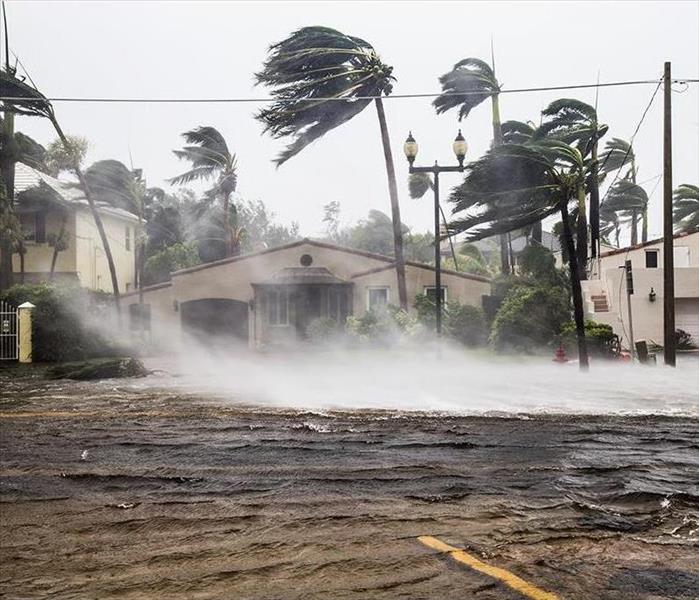 Make sure you are prepared.
Make sure you are prepared.
Hurricane season is upon us, and there are several named storms that have developed in the Atlantic, Caribbean and Gulf of Mexico. On average, there are about 12 tropical storms that will develop between June 1st and November 30th. Of those 12 storms, 6 of them will become hurricanes according to the National Weather Service. We know that hurricanes can be life-threatening, and they can cause a serious amount of property damage. The National Weather Service lists the following as potential "hurricane hazards".
Storm surge: is the abnormal rise of water generated by a storm's winds. This hazard is historically the leading cause of hurricane related deaths in the United States. Storm surge and large battering waves can result in large loss of life and cause massive destruction along the coast. It can also travel several miles inland, especially along bays, rivers and estuaries.
Flooding: from heavy rains is the second leading cause of fatalities from landfalling tropical cyclones. Widespread torrential rains associated with these storms often cause flooding hundreds of miles inland. This flooding can persist for several days after a storm has dissipated.
Winds: from a hurricane can destroy buildings and manufactured homes. We also see that signs, roofing material and other items left outside can become flying missiles during a hurricane.
Tornadoes: can accompany landfalling tropical cyclones. They typically occur in rain bands well away from the center of the storm.
Dangerous waves: produced by a tropical cyclone's strong winds can pose a significant hazard to coastal residents and mariners. These waves can cause deadly rip currents, significant beach erosion and damage to structures along the coastline. This is even when the storm is more than a 1,000 miles offshore.
With this all being said, preparation is the best protection against the dangers of a hurricane. Make sure you plan an evacuation route and your emergency plan, take inventory of your property and take steps to protect your home or business.
Tornado Season
8/4/2020 (Permalink)
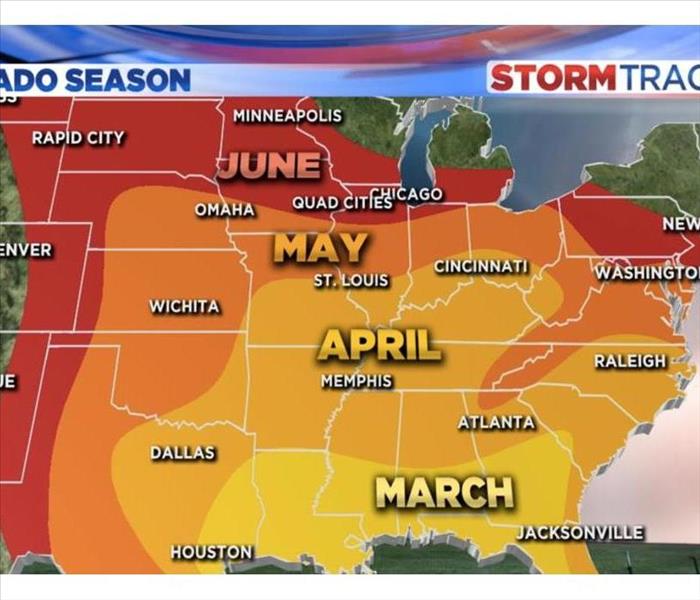 Check this out!
Check this out!
Tornadoes can occur year-round anywhere over the lower 48 of the United States, but the spring to summer period is prime time for severe thunderstorms that spawn the violent swirling columns of air. Building warmth and surging humidity are key ingredients for thunderstorms which, when severe, can evolve to produce tornadoes.
Severe thunderstorms will typically form when we get warm, moist air from the Gulf of Mexico clashing with cool air from Canada and sometimes dry air from the deserts. We often see the most tornadoes develop from central Texas, northward through the Nebraska and Iowa area, which is referred to as "Tornado Alley".
In order for severe thunderstorms to form, there must be a mechanism for air to rise in vigorous fashion. As a column of air rises through the atmosphere, it cools and causes moisture within to form the towering clouds we see as thunderstorms. The more moisture available and the cooler the air is aloft, the more efficient and potentially the more violent this process is. A push of dry air or cooler air from the outside can also intensify this process.
Any time there is a surge in temperature and humidity levels, combined with the approach of cooler and drier air thunderstorms can erupt. the most dramatic time of the year for this is in the spring to early summer. The peak for severe weather and tornado season is from April through June. Areas of the country that typically warm up the fastest with an ample supply of moisture are usually the most likely areas for early-season severe thunderstorms and tornadoes.
What Causes Sewage Backup During a Storm?
11/12/2019 (Permalink)
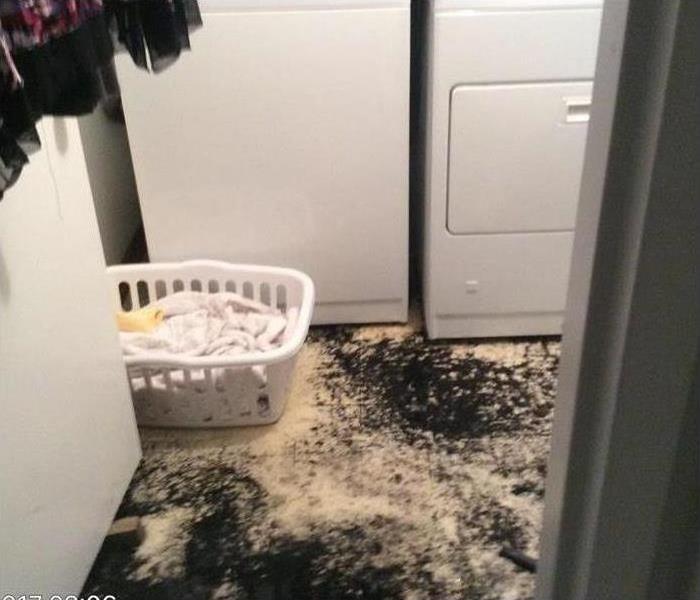 Sewer water backup in a laundry room
Sewer water backup in a laundry room
What Causes Sewage Backup During a Storm?
A flooded basement can be devastating, especially if you use that space to store valuable heirlooms or photos. Unfortunately, this is a common problem with several causes, including:
- Sewer water backing up into your home
- Surface water flowing near the foundation
- Groundwater being pushed into the basement
Surface water often comes into the basement via clogged gutters or sloped pavements and landscapes. These problems are relatively easy to fix.
Preventing groundwater flooding is a bit more complicated. Groundwater can seep into the basement when hydrostatic pressure pushes the fluid through holes or cracks in the floor. Still, there are ways to prevent this issue, namely installing a drain system to reduce the hydrostatic pressure.
Sewage Backup
Major storms can also lead to a flooded basement in your Forest Park, IL, home. This is particularly a problem in houses built before 1980. Many of these homes contain an exterior drain at the basement level that attaches via a pipe to the city's sewage system. If the rain level in that system gets too high during a storm, the water can flow back toward your house. You may be able to solve this issue by installing an interior drain system with a sump pump.
Even newer homes may have to deal with sewage problems during storms, however. The local sewage system is often overwhelmed during major rainstorms, causing sewer water to back up into homes. Keeping your pipes clear of tree roots and installing backflow valves can help protect your home from sewage backup. However, you cannot completely prevent it from occurring.
Dealing With Basement Flooding
No matter what the cause, a flooded basement can cause plenty of damage. The water can destroy the walls and floors. It can also contaminate any belongings you are storing in that room.
Thankfully, your home and your possessions can be saved with the help of an emergency restoration company. Cleanup professionals do more than just drain the water from your property. They can also disinfect your house, remove any odors and excess mold, and take care of your personal items.
Signs of Wind Damage to Your Commercial Roof
10/26/2019 (Permalink)
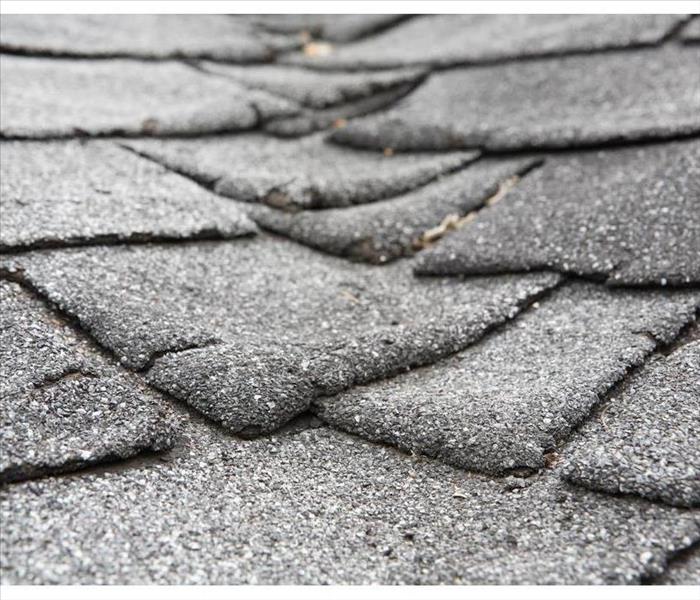 Damaged shingles on roof
Damaged shingles on roof
Common Signs of Wind Damage That You Might Find on Your Commercial Building
After a storm hits your business in La Grange Park, IL, you may notice various forms of damage on your property. The high winds can lead to roof damage, structural problems and other complications. No matter what kinds of issues you are experiencing, the key to addressing them properly is to know how to identify them. Here are some common signs of wind damage that you may find on your commercial building.
Curling Shingles
One potential issue that may result from high winds is curling shingles. When looking for signs of these damaged materials, be sure to check the following areas:
- Edges and corners of roof
- Area surrounding chimney
- Roof ridge
If you locate damaged shingles on your roof, make sure that you call a professional as soon as possible. Shingles that have begun to curl don’t function as effectively, which means they pose the risk of allowing water to leak through the roof. This can lead to severe water damage in your business if you don’t take care of the issue promptly.
Roof Leaks
A leaking roof is another form of roof damage that you should address right away. Leaks can appear in many places on your roof. To identify a problem, check the top floor of your building for any wet spots on the ceiling. Because leaks can lead to more serious water damage if left unaddressed, be sure to have them repaired immediately.
Chimney Damage
If you come across any forms of damage to your chimney, this could be a sign that you need to schedule a roof rebuild. When inspecting your chimney, check to see if there are any issues with the flashing. If it is split or missing, this is a major indicator that your roof has been hit by wind damage.
Any kind of roof damage to your La Grange Park, IL, business should be taken seriously. Contact emergency restoration services immediately to help your building recover from the effects of a storm.
4 Things To Do If Your Roof Collapses
9/10/2019 (Permalink)
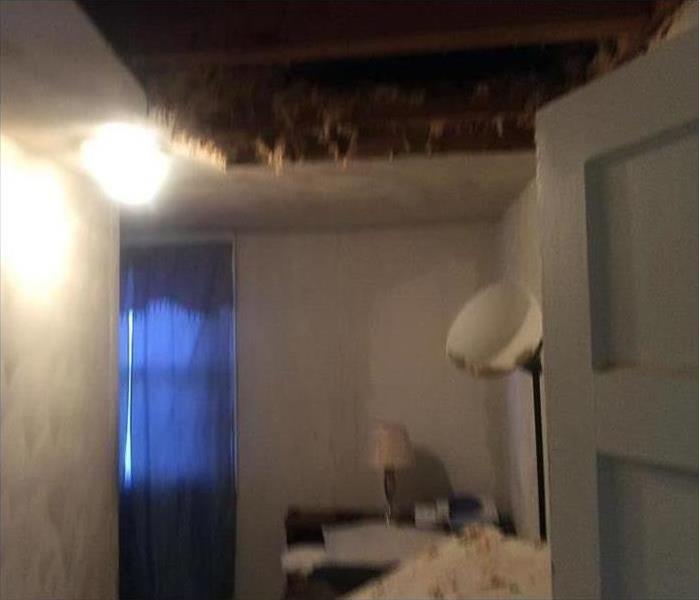 Roof collapsed in a Maywood, IL home
Roof collapsed in a Maywood, IL home
4 Things To Do If Your Roof Collapses
There are plenty of DIY projects you can tackle at home, but if a winter storm or blizzard blows in to Maywood, IL, leaving serious roof damage behind, it is time to put down the hammer and pick up the phone. Disaster cleaning after a roof cave-in or storm damage is a job for professionals.
Do Not Enter
If a storm has caused your roof to collapse, do not go back in the house for any reason. Instead, you should do the following:
- Get out.
- Don't stop to search for, or collect, personal belongings.
- Take your family to a place where they are safe from the blizzard.
- Call 911.
Contact Your Insurance Agent
As soon as your family is safe, call your insurance agent. Let your agent know what has happened and check on what your policy will cover. Then call a company that handles winter storm restoration.
Call a Professional
A home with structural damage such as a roof collapse calls for specialized skills, and you will need to call in a professional restoration team to handle the job. They will take care of cleanup and repairs and help get your life back to normal as quickly as possible. Cleanup and restoration after a roof collapse or other serious roof damage usually involves the following steps:
- Clearing debris, such as dry wall, boards or broken pipes
- Drying the area using fans and heaters
- Repairing areas with water damage
Stay in a Hotel
Make arrangements for your family to stay outside your home for a week or more. You could stay with friends or relatives, or you may prefer a hotel. Be sure to ask your insurance agent what your policy covers in this regard, and then relax.
A winter storm can be stressful, but the cleanup doesn’t have to be. When the restoration team is finished, it will look “Like it never even happened.”
Preparing Your Business for a Severe Storm
8/20/2019 (Permalink)
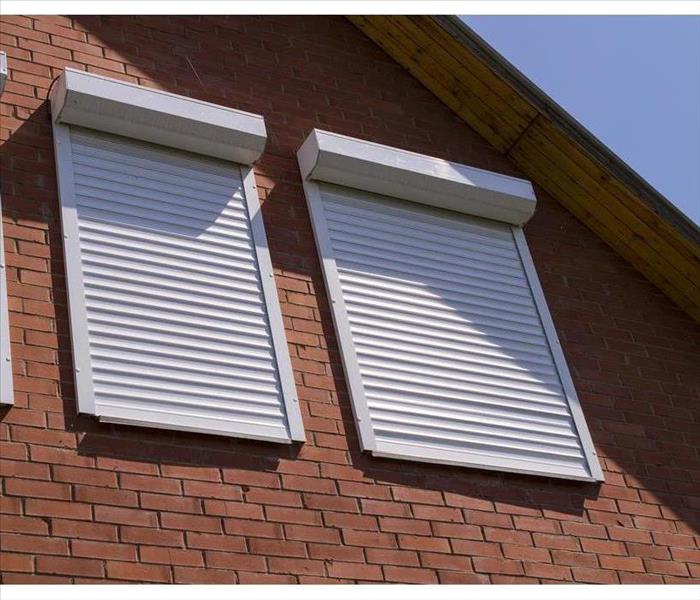 Invest in operable shutters to protect windows from high winds
Invest in operable shutters to protect windows from high winds
A rainstorm or thunderstorm can occur suddenly, and you may not always have adequate time to prepare. Luckily, there are steps you can take now to prepare your North Riverside, IL, business for inclement weather.
Before a Storm
Unfortunately, storms can damage property and injure customers and employees. Here are some tips for minimizing damage:
- Invest in operable shutters to protect windows from high winds.
- Make sure all trees close to your business are healthy, and keep limbs trimmed.
- Install surge protectors or other forms of lightning protection.
- Inspect the roof to make sure it can withstand heavy rains.
- Create a plan for yourself, employees and customers in case severe weather strikes during business hours.
During a Storm
The storm plan you create should include basic safety precautions such as not using landline phones or running water, staying away from windows, etc. It should also list the safest areas of the business to go during a storm. If you have employees that may be out of the office when a storm hits, be sure to include information about how to stay safe while on the road during a thunderstorm or rainstorm, i.e., pull over as soon as possible and stay in the vehicle with the windows up.
After a Storm
Although much of the danger is over by the time the skies clear, there are still risks to both people and property. Be sure to avoid downed power lines and report them to the proper authorities. Also, never attempt to drive through a flooded area. After you ensure the safety of your employees and customers, it is important to begin repairing any damage. Before beginning repairs, though, be sure to take either photos or video for the insurance company. After documenting the damage, begin cleanup efforts as soon as possible. Water damage can quickly turn into mold growth which can further harm your property.
Preparing for a storm will go a long way toward minimizing damage, but you may still need to hire a certified restoration company to get your business back to normal after a thunderstorm or rainstorm.
Avoid These 3 Causes of Sewage Backup
7/9/2019 (Permalink)
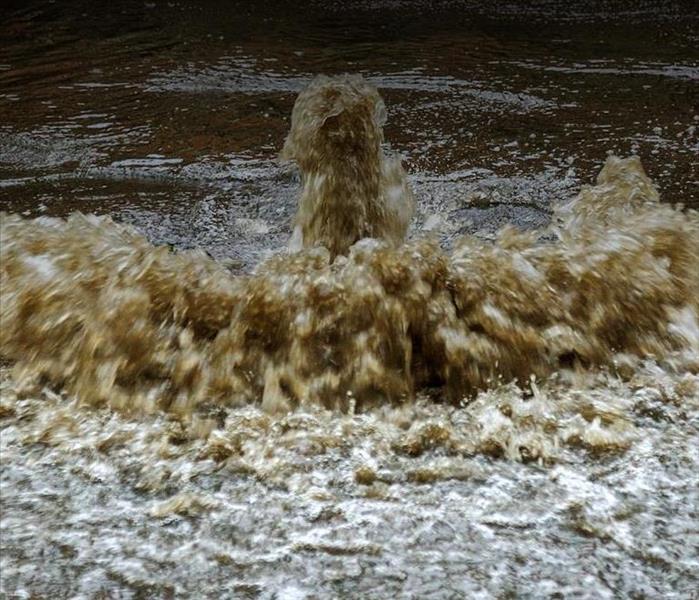 Sewage overflow in Lyons, IL
Sewage overflow in Lyons, IL
Three Possible Causes of Sewage Backup
If you are a homeowner in Lyons, IL, whose house has suffered damage from a backed-up sewer, one of the biggest impact areas will likely be your basement. A flooded basement can be inconvenient and expensive to deal with, so putting in measures to prevent such an occurrence is highly advisable. Here are three possible causes of sewage backup to keep in mind.
1. Sewage Overflow
Sewage systems are designed to have a maximum water-holding capacity. Thus, when there is a heavy downpour and the amount of water coming in exceeds the capacity of a sewer, there is a high likelihood of flooding even though the system may be in perfect working condition.
2. Old Sewage Systems
The average age of many public sewage systems in the U.S. is 30 years. As a result, many of them are more susceptible to damage now than in the past. This means that if your home in Lyons, IL, is connected to any such public system, there is a bigger risk of suffering a flooded basement. Similarly, if you live in an older home, your plumbing may be nearing the end of its life span. Replacing old pipes and valves before they deteriorate can prevent a backup of sewage.
3. Blocked Pipes and Drains
When foreign materials get into drains and pipes, it can result in water backing up and, ultimately, flooding. Pipes can get clogged when solid substances are thrown into sinks, flushed down toilets or washed into drains from the outside. To keep your pipes and drains clear, be sure to get rid of oil and grease properly. You should also take care not to use toilets and sinks to dispose of items that do not easily degrade.
A flooded basement can cause a lot of anxiety and discomfort to a homeowner. If you find yourself surrounded by unwanted water, consider consulting a reputable water damage restoration company to help.
Hail Damage to Roof Can Cost You Money
6/28/2019 (Permalink)
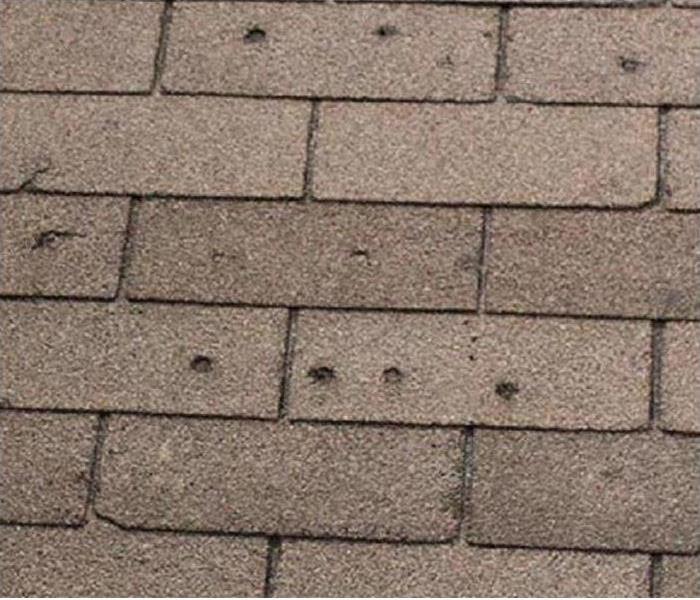 Hail Damage on roof is common after a storm.
Hail Damage on roof is common after a storm.
Hail Damage can be costly.
What is hail?
"Hail is large, layered ice particles, often spherical in shape, which are produced by thunderstorms having strong, tilted updrafts. Hailstorms form within a unusually unstable air mass, that is, an air mass in which the temperature falloff with height is much greater than normal." (The Weather Channel)
How can hail damage your roof?
"Basically, hailstones one inch in diameter begin causing damage to some of the older, thinner roof products. Therefore, from a roof damage perspective, we believe the hail size threshold for issuing a severe thunderstorm warning can be increased from ¾ of an inch to one inch in diameter." (Travelers Insurance) Hail larger than 0.75 inches is considered large enough to cause serious damage in the United States. Per NOAA, hailstones can fall at speeds up to 120 mph. The largest hailstone ever recorded in the United States was 8 inches in diameter, weighing nearly 2 pounds.
How do you know if you have roof damage from hail?
Set up a ladder to your roof to examine the top of the roof. Check the ridge cap of the roof for dents. This area of the roof will receive the most damage from hail since it is flat and will take a direct hit in a storm. Look at the shingles. Check the whole shingle, as well as the edges, for signs of damage.
If climbing up a ladder is not your thing, call SERVPRO of LaGrange Park/North Riverside at 708-240-4873, and we will take a look at your roof for hail and other roof damage for you.
3 Things You Should Know About Commercial Generators
5/7/2019 (Permalink)
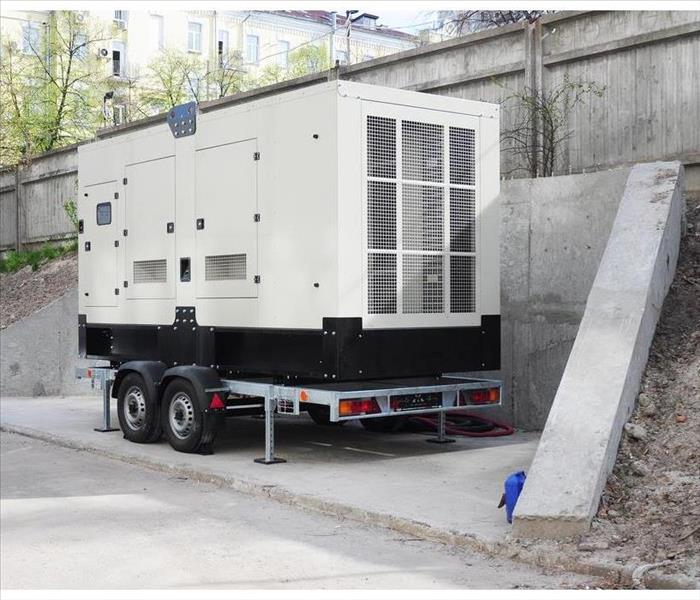 A commercial generator can help you continue running your business as usual until power is restored
A commercial generator can help you continue running your business as usual until power is restored
Things You Should Know Before Buying a Commercial Generator
When you are experiencing severe weather, it is possible that the power might go out in your Lyons, IL, building. While you could decide to just call it a day, your business would lose valuable time and profits, especially if the power outage lasts for a while. Investing in a generator is another option. Here are a few things that you should know before buying one.
1. How Do They Work?
This alternative power source runs on fuel and can be used as a temporary source of electricity in the event of a power outage. Using an engine, it supplies an electrical output that you can connect to your building. It can help you continue running your business as usual until power is restored.
2. How Long Can You Run It?
The length of time that you can run your machine depends on the type that you have and ranges from a few hours to several days. For business purposes, a permanent generator would likely be more appropriate. They can supply additional energy for longer periods of time than the portable variety. If you want to continue operating as normal, this is the option that you would need. However, if you only need power to keep your computers running long enough to save any important files, then a smaller machine would suffice.
3. When Will It Need To Be Replaced?
Over time, your machine will begin to work less efficiently, and components may begin to fail. Many are designed to last for 3,000 to 5,000 hours. While it can vary depending on how often you need to use it, this can usually give you between 20 to 30 years of use. To prevent generator problems and keep it working as long as possible, you should be sure to perform regular maintenance.
Using a generator can help keep your business operating during a storm, but in the case of severe weather, your commercial building may experience some damage. If this happens, an emergency repair service can help to quickly get everything back to its previous condition.
Thunderstorm Safety
5/2/2019 (Permalink)
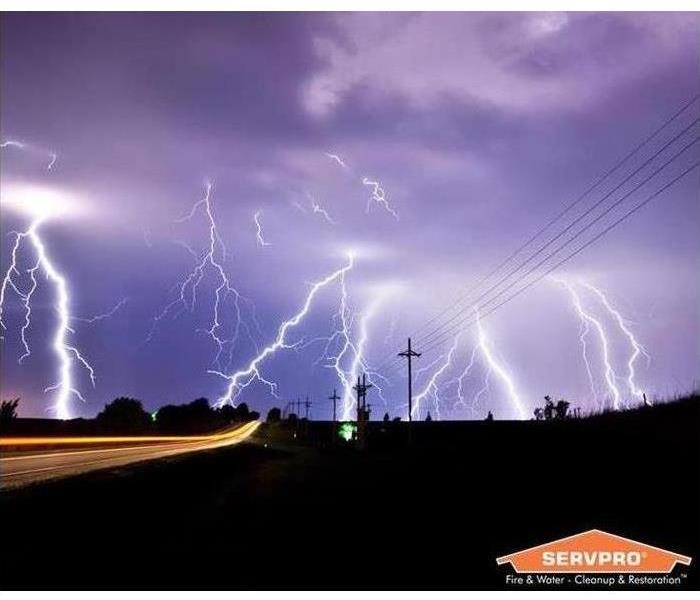 Thunderstorms can be very dangerous if we are not prepared.
Thunderstorms can be very dangerous if we are not prepared.
All thunderstorms are dangerous, and every thunderstorm produces lightning. "While lightning fatalities have decreased over the past 30 years, lightning continues to be one of the top three storm-related killers in the United States. People struck by lightning often report a variety of long-term, debilitating symptoms." According to the researchers at The Weather Channel.
How do you prepare for a thunderstorm?
According to ready.gov, "To prepare for a thunderstorm, you should do the following:
- To begin preparing, you should build an emergency kit and make a family communications plan.
- Remove dead or rotting trees and branches that could fall and cause injury or damage during a severe thunderstorm.
- Postpone outdoor activities.
- Secure outdoor objects that could blow away or cause damage.
- Get inside a home, building, or hard top automobile (not a convertible). Although you may be injured if lightning strikes your car, you are much safer inside a vehicle than outside.
- Remember, rubber-soled shoes and rubber tires provide NO protection from lightning. However, the steel frame of a hard-topped vehicle provides increased protection if you are not touching metal.
- Shutter windows and secure outside doors. If shutters are not available, close window blinds, shades or curtains.
- Unplug any electronic equipment well before the storm arrives."
Finally it is important to familiarize yourself with these terms to help identify a thunderstorm hazard:
Severe Thunderstorm Watch - Tells you when and where severe thunderstorms are likely to occur.
Severe Thunderstorm Warning - Issued when severe weather has been reported by spotters or indicated by radar. Warnings indicate imminent danger to life and property to those in the path of the storm.
Water, and fire damage call both happen during a thunderstorm event. SERVPRO of LaGrange Park/North Riverside is here to help. Give us a call at 708-240-4873 for all your restoration needs.
3 Things You Should Know About Flood Zones
4/26/2019 (Permalink)
 Living in a flood zone can make things more difficult for you, depending on the usual severity of flooding.
Living in a flood zone can make things more difficult for you, depending on the usual severity of flooding.
As a homeowner in La Grange, IL, it is important to have as much information as possible to keep your family and your property safe, but there are some things you may not think to consider. Whether or not your home is located in a flood zone might not usually cross your mind, but this knowledge can be incredibly helpful. Here are a few things that you should know about these areas.
1. What Is It?
As the name suggests, a flood zone is an area that has an increased risk of flooding during severe weather. The Federal Emergency Management Agency, or FEMA, determines the risk in each area and gives them a rating based on the type of floods that occur and the severity of the damage it causes.
2. How Do You Determine if You Are in One?
If you want to see if your home is in one of these zones, the process is simple. FEMA provides resources, such as a Flood Insurance Rate Map, that homeowners can download from their website. This will show you in which type of zone your property is located. Their maps are updated often, so you can check back over time to see if there have been any changes.
3. How Will This Affect You and Your Property?
Living in a flood zone can make things more difficult for you, depending on the usual severity of flooding. In some cases, you may end up with damage to your home that requires an emergency restoration service. You might be required to purchase additional flood insurance for your home as well.
While owning a home in one of these areas might not be ideal, having the necessary information can help you be more prepared in case of an emergency. If you know that there is a storm coming, take steps to keep your family and belongings safe. If there is damage to your home, know that there are services available to help.
Flood Safety Tips
3/27/2019 (Permalink)
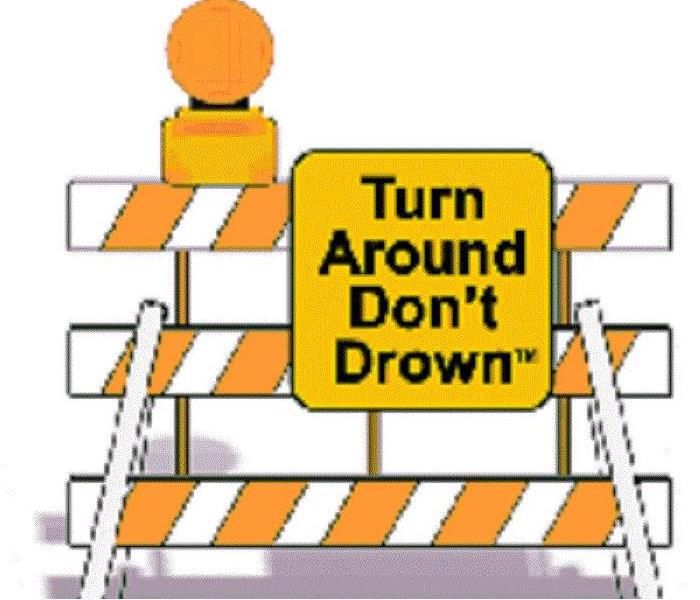 Stay safe during a Storm and take all the precautions necessary to avoid severe Storm Damage.
Stay safe during a Storm and take all the precautions necessary to avoid severe Storm Damage.
Flood can happen anywhere, and without much of a notice. According to ready.gov “Just 6 inches of moving water can knock you down, and 1 foot of water can sweep your vehicle away.” Flood Watches and Flood Warnings are available to let you know what the weather is doing in your area. On average, more deaths occur due to flooding each year than from any other severe weather related hazard.
First of all flood watches and flood warnings are two separate alerts to warn about the weather in your area. A flood watch is to make you aware that conditions are possible for flooding. A flood warning means you need to take action to keep yourself and your family safe.
Ready.gov has some safety tips in case you are in an area where there is a flood warning.
- Move immediately to higher ground or stay on high ground.
- Evacuate if directed.
- Avoid walking or driving through flood waters. Turn Around, Don’t Drown! Just 6 inches of moving water can knock you down and 1 foot of water can sweep your vehicle away.
The water from a flood is only one of the risks. Water and electricity do not mix. In the event of a flood, downed power lines are also possible. Stay away from all power lines. Calling your local utility company is the only thing you should do in the event you see downed lines. Your appliances, if they get wet, should also not be used until they have been inspected by a licenses electrician. The fuse box in the house should be avoided as well as long as there is water in the home.
We may not be able to control weather conditions, but we can take all possible precautions to ensure our personal safety and protect our homes from severe damage.
According to ready.gov the following tips can help prepare you for a flood:
- Find out how vulnerable your home is to flooding by determining the elevation of your property.
- Evaluate your insurance coverage once a year to make sure your home is fully covered. As new construction grows in certain areas, more flood-plains are sometimes created.
- If your home is in a flood-prone area, contact the National Flood Insurance program to learn what mitigation measures you can take in advance.
- Contact your local emergency management agency to learn how to construct proper protective measures around your home.
- If you live in a flood-prone area, keep these materials on hand: sandbags, plywood, lumber, plastic sheeting, trash bags, shovels, work boots and gloves.
- Purchase a weather radio. These special, battery-operated radios cost as little as $20 and are available at many hardware and appliance stores and other retail outlets.
- Put together a disaster survival kit. Keep the following supplies near at hand and put them in a water-tight container: flashlight with extra batteries, battery-powered radio and weather radio, first aid kit, medicines, eyeglasses, drinking water, non-perishable foods, change of clothes, cash and credit cards, and copies of all important papers.
- Plan two evacuation routes in advance. Don’t wait until threatening weather conditions occur before trying to determine your route to safety. Be aware of streams, drainage channels and low areas in your region that are prone to flooding, so that your evacuation routes are not cut off.
- Do not park your vehicle near streams or rivers, especially during threatening weather conditions.
As always, SERVPRO of LaGrange Park/North Riverside wants you to stay safe first and foremost. However, flooding happens, and we are here to help.
If you have flood damage in your home, call us at 708-240-4873 for all your water damage needs.
POLAR VORTEX 2019 SERVPRO
1/29/2019 (Permalink)
As a polar vortex rolls across the United States in this week, there is a point when we have a lower temperature than Antarctica. Take a second to think about that.
Although temperatures in LaGrange Park and Chicago-land drop quickly, we will fair better than other areas.
Unfortunately for homeowners and business owners in our area, the drop will still wreak havoc with their pipes. Being overwhelmed on what to do is going to be the first thought. That is why you need a plan and a company.
Many homes and businesses will call about burst pipes, flooded basement and closed office due to sprinkler breaks and will be put on wait lists.
Although it does seem like some of these burst pipes will be inevitable, there are a few precautions that you can take to avoid a major loss when the temperatures drop.
Insulate Pipes
Insulating your pipes is inexpensive compared to the cost of a water damage and is easy to do yourself. This is the first step when preparing your house for cold weather.
Insulate Everything Else
Make sure there is plenty of insulation in your attic and crawlspace. This will keep everything in your house warmer including your pipes.
Run Faucets
When you know that there is going to be a big temperature drop, like the recent polar vortex, don't give water a chance to freeze by running it. The smallest stream from a faucet will keep the water moving and prevent freezing. This is especially important to do with faucets that are served by exposed pipes.
Keep Garage Door Closed
If there are pipes in your garage, you need to keep it as warm as possible. Do not leave it open and try to open it only when absolutely needed.
Remove, Drain, and Store Hoses
Water in hoses can freeze and start a chain reaction that will lead back into your house. Prevent this by removing all hoses from the house and draining them.
Open Cabinets
Open cabinets in the kitchen and bathroom to get some warmer air moving beneath your sinks.
Keep House Temperature Consistent
Most people drop the temperature in their house down at night. When temperatures are especially cold, it is best to keep the house at a higher consistent temperature. The price of heat is nothing compared to the price of a burst pipe.
Set Temperature When Out of Town
If you will be out of town during the winter, make sure to keep the temperature of your house above 55 degrees at the very least.
Following these simple steps can go a long way in preventing a major water damage. For the losses that cannot be prevented, remember to call us at SERVPRO of LaGrange Park/N. Riverside at 708-240-4873!
Summer Storm Tips
7/23/2018 (Permalink)
During the summer months, our minds are preoccupied with vacationing, grilling burgers with the family, and focusing on getting that bronze tan at the poolside. Yet, most of us leave our most valued possessions unprepared for the alarming and unpredictable summer storms: our homes.
Each year, thunderstorms alone cause an astonishing $15 billion in property damage. Summer and spring seasons are the most vulnerable to these destructive and frightening storms. Hailstorms result in approximately $1 billion of property damage a year. Thunderstorm winds can reach over 100 mph with an outcome of severe roof and house siding damage. Flooding causes billions of dollars a year in damage to homes and sadly some result in total loss of residences.
Here are some summer time safety tips to keep in mind during summer storms:
- Know the safest structure of your home to go to during a severe storm such as a basement, underground cellar, or even the most inner part of your home away from windows.
- Take summer storm warnings and alerts seriously, especially tornado and hurricane warnings! Tornadoes and hurricanes can lead to total property loss and even death.
- Invest in storm windows.
- Contact your insurance company to be more familiar with your policy. Most home insurers do not cover flooding damage.
- Cut down any unwanted trees or limbs and get your trees trimmed before summer storm season. Trees and branches can fall on your property and damage the siding or windows due to those powerful 100 mph thunderstorm winds.
- Get routine maintenance on your roof and the foundation! Cracks in the roof are the number one leading cause to flooding damage.
Summer storms can happen at any time. Make sure you home is ready, and your family is safe. Unfortunately, we all know things happen, even to the most prepared home. SERVPRO of LaGrange Park/North Riverside is here to help! Give us a call at 708-240-4873 for all your water damage needs.
Prepping Your Property For Summer Storms
6/29/2018 (Permalink)
Have an emergency kit with these items you probably already have in your home: flashlight(s), battery powered weather radio, extra batteries to fit each electronic (including cell phone), non-perishable foods (canned goods and dry foods), lots of bottled water, can opener, first aid kit (with a disinfectant), fire extinguisher, blankets, extra clothes, sturdy shoes or boots, clock or watch, whistle to signal for help, important personal items (eyeglasses, prescriptions, etc.), and paper documents such as birth certificates, social security cards, and other significant legal papers.
- Know the safest structure of your home to go to during a severe storm such as a basement, underground cellar, or even the most inner part of your home away from windows.
- Get routine maintenance on your roof and the foundation! Cracks in the roof are the number one leading cause to flooding damage.
- Cut down any unwanted trees or limbs and get your trees trimmed before summer storm season. Trees and branches can fall on your property and damage the siding or windows due to those powerful 100 mph thunderstorm winds.
- Contact your insurance company to be more familiar with your policy. Most home insurers do not cover flooding damage.
- Keep all expensive and favored possessions off the floor and away from low ground in case of flooding. Keep them in the highest part of the home preferably.
- Invest in storm windows.
- Keep all patio furniture, grills, etc. in doors before a summer storm hits. Do not forget to park your vehicles in the garage!
- If your town is evacuating due to a hurricane, secure and board up windows and any openings of your home.
- Finally, take those summer storm warnings and alerts seriously, especially tornado and hurricane warnings! Tornadoes and hurricanes can lead to total property loss and even death.
SERVPRO of LaGrange Park/North Riverside is here to help. Water damage, fire damage, and storm damage can cause serious damage to your home or commercial property. Give us a call at 708-240-4873 for all your restoration needs.
Do's & Don’ts of Flood Damage Cleanup
6/25/2018 (Permalink)
The first thing you will need to do after a flood is make sure that it’s safe for you and your family to be on the property. SERVPRO has the ability to pull our resources in the event of a flood and can be onsite to assist you in the event of a flood. Here is a list of Do's and Don'ts after a flood for you to consider.
- DO beware of rodents, snakes and insects that might have come in with flood waters
- DO smell for gas and look for damaged power and gas lines, foundation cracks and exterior damage
- DO look for broken pilings, shifted stairs, slanted floors and walls
- DO turn off water and power (unless you would have to do so while standing in water)
- DON’T enter your home or business if you see major structural damage
- DON’T walk on sagging floors or floors above sagging ceilings
- DON’T use electrical appliances or turn on ceiling fans and lights if the ceilings are wet
Once you’re ready to start the cleaning process, it’s important to prioritize. At this stage:
- DO check that your running water is safe to drink and to use for cleaning
- DO flush your toilet before you use it to check for clogs from mud and debris
- DO check for cabinets and other items that may be ready to fall over
- DO temporarily patch holes in the walls and roof with plastic wrap and repair floors and roof sections with 4X4s if you can do so safely
- DO remove debris
- DO remove water trapped in walls
- DO open all the doors and windows to improve ventilation
- DO use a wet vac, shop vac, fans, dehumidifiers and desiccants (materials that absorb moisture) to start drying out the property
- DON’T drain a flooded basement too quickly, because rapid changes in pressure could cause the foundation to collapse
- DON’T do structural or electrical work yourself
- DON’T connect generators to the home’s power system, but plug in fans and appliances directly
- DON’T use generators, grills, camp stoves or charcoal inside homes or within closed areas
- DON’T use a household vacuum to remove water and mud
- DON’T let garbage pile up, as it could exacerbate contamination and house pests
- DON’T leave pools of standing water, which could become breeding grounds for mosquitoes
Floods are serious events to a persons home or business, SERVPRO of Lagrange Park/North Riverside is always here to help. Give us a call at 708-240-4873. We will make it “Like it never even happened.”
Tornado Season Safety
5/21/2018 (Permalink)
Tornado season is just ahead of us, and it’s never too early to plan ahead for a storm. The Red Cross has listed some great tips to keep in mind during a tornado.
- Identify a safe place in your home where household members and pets will gather during a tornado: a basement, storm cellar or an interior room on the lowest floor with no windows.
- In a high-rise building, pick a hallway in the center of the building. You may not have enough time to go to the lowest floor.
- In a mobile home, choose a safe place in a nearby sturdy building. If your mobile home park has a designated shelter, make it your safe place. No mobile home, however it is configured, is safe in a tornado.
Another way to keep your family safe is to know the difference between and tornado warning and a tornado watch. According to the National Weather Service, a tornado watch means that a tornado is possible in the area. A tornado warning means that a tornado is already occurring or will occur soon. You need to immediately find a safe place.
If you find yourself outside during a tornado, seek shelter in sturdy building or basement. I f you cannot quickly walk to a shelter, immediately get into a vehicle and try to drive to the closest sturdy shelter. Stay away from bridge/highway overpasses. f strong winds and flying debris occurs while driving, pull over and park, keeping your seat belt on and engine running. Put your head down below the windows, covering your head with your hands and a blanket.
Your safety is your most important thing during a tornado. We are here to help! SERVPRO of LaGrange Park/North Riverside is here to help for all your cleanup needs in the event of a tornado. Give us a call at 708-240-4873.
Helpful Tips to Prepare Your Home for Spring Storms
4/30/2018 (Permalink)
Spring has arrived in LaGrange Park, and taking a few preventative steps now, can save you from dealing with substantial damage to your home later. With the warm temperatures, spring cleaning projects are an ideal time to start, but it is also an ideal time to start thinking on how to improve your property to prevent storm damage.
Here are some tips from Access Home Insurance to help you spark improvement projects this spring in your home.
- Identify any existing roof or siding problems:A licensed contractor can inspect your roof for missing shingles and possible leaks and do any repair work if necessary. It’s also a good idea to inspect and reinforce any loose siding, which can quickly rip off during high winds.
- Use shredded bark mulch as landscaping material:If you have rock or gravel landscaping, it’s a good idea to replace it with bark, which won’t cause damage if blown around in high winds.
- Maintain trees and shrubbery in your yard: Spring is the perfect time to remove dead or weak branches or remove trees that could fall on your home during a storm. Check trees and shrubs regularly to identify potential problems.
- Ensure gutters aren’t loose or clogged:Clear your gutters of debris and make sure they are tightly attached to your house. Strong winds can quickly tear loose gutters from your home and cause damage. Also, it’s important to make sure downspouts are positioned away from your home’s foundation to help prevent basement flooding.
- Secure top-heavy furniture: Don’t forget about the inside of your home too. Walk around your house and secure large, top-heavy pieces, such as bookcases, to the wall.
If you have questions about projects around your home that need to be taken care of before the spring storms begin, give SERVPRO of LaGrange Park/North Riverside a call at 708-240-4873. We are always here to help.
How To Prepare Your Home For Winter Storms
3/5/2018 (Permalink)
Winter is very hard on your home and can cause all sorts of damage. You can prepare your home for winter storm weather by following these safety tips.
Learn to protect your pipes from freezing. You can drain the water from outdoor supply lines. You can detach your water house, and close the valve. Your indoor pipes can be protected as well by dripping the faucet to keep the line open. You can also open cabinet doors to allow the heat from your home to keep the pipes above freezing.
Make sure your home is properly insulated. Caulk and weather-strip doors and windowsills to keep cold air out. You can buy weather stripping to put under any doors that have air leaking from underneath as well.
Install storm windows or cover windows with plastic from the inside to provide an extra layer of insulation to keep cold air out. Purchasing premade window kits will allow you to easily unpack the kit and install the plastic to your windows.
Consider buying emergency heating equipment, such as a wood- or coal-burning stove or an electric or kerosene heater. Remember, for your safety to vent the wood and coal- burning stove. Electric space heater needs to be at least 3 feet away from anything that can catch on fire, and make sure you unplug the heater when it is not in use.
Prepare your fireplace, if you have one. Have a supply of wood on hand so you can use the fireplace as a heating supply in your home. Always make sure that the fireplace is in good working order and is vented property before use.
SERVPRO of LaGrange Park/North Riverside is always here to help. If you have damage to your home due to a winter storm, we are here to help. Call us at 708-240-4873.
What To Do Before a Winter Storm Hits
2/12/2018 (Permalink)
Winter storms can hit at any moment in the winter time here in Chicagoland. We all know the first thing we do is run to the local grocery store and stock up on the basics, but what else can you do to be prepared for a winter storm?
The American Red Cross gives some tips for you to consider before a winter storm hits.
* Listen to local area radio, NOAA radio or TV stations for the latest information and updates.
* Be prepared to evacuate if you lose power or heat and know your routes and destinations. Find a local emergency shelter.
* Check emergency kit and replenish any items missing or in short supply, especially medications and medical supplies. Keep it nearby.
* Be sure you have ample heating fuel.
* If you have alternative heating sources, such as fireplaces, wood- or coal-burning stoves, or space heaters, be sure they are clean and in working order.
* Check that your fire extinguisher(s) is in good working order, and replace it if necessary.
* Bring your companion animals inside and ensure that your horses and livestock have blankets if appropriate and unimpeded access to shelter, food, and non-frozen water.
SERVPRO of LaGrange Park/North Riverside is always here to help. If you have damage to your home due to a winter storm, we are here to help. Call us at 708-240-4873.
Winter Weather Preparedness Guide
1/17/2018 (Permalink)
Protecting your home is vital in the winter months. A frozen water pipe can burst and flood your house. An ice dam in your gutter can cause water to seep into and saturate an interior walls of your home. Here is a list from Nationwide insurance that they advise their homeowners on during the winter months to prepare their homes for the cold.
- Clean out the gutters, disconnect and drain all outside hoses. If possible, shut off outside water valves.
- Insulate walls and attics, and caulk and weather-strip doors and windows.
- Repair roof leaks and remove tree branches that could get weighed down with ice or snow and fall on your house – or your neighbor's. (Avoid liability for the latter.)
- Wrap water pipes in your basement or crawl spaces with insulation sleeves to slow heat transfer.
- Consider an insulated blanket for your hot water heater.
- If you have a fireplace, keep the flue closed when you're not using it.
- Have a contractor check your roof to see if it would sustain the weight of a heavy snowfall.
- Make sure your furniture isn't blocking your home’s heating vents.
- During cold spells, keep cabinet doors open to allow warm air to circulate around pipes, particularly those in the kitchen and bathrooms.
- Keep a slow trickle of water flowing through faucets connected to pipes that run through unheated or unprotected spaces.
- If your house will be unattended during cold periods, consider draining the water system.
- Avoid ice dams– where water from melted snow refreezes in the gutters and seeps in under the roof, soaking interior walls. Here’s how:
- Ventilate your attic.
- Insulate the attic floor well to minimize the amount of heat rising through the attic from within the house.
- Consider having a water-repellent membrane installed under your roof covering.
If you do find that you have damage to your home, the Insurance Information Institute has published some tips on what to do in the case of a winter storm and managing the damage to your home.
- Take pictures of the damage immediately. If you have "before" pictures, that's even better. Those pictures will help ensure that your insurer cannot claim that the problem was preexisting.
- Make temporary repairs to keep the damage from getting worse but hold on to all of your receipts.
- Don't make pricey repairs before the insurance adjuster arrives.
- Don't assume something is not covered. Take out your policy. Most weather-related damage like burst pipes, a collapsed roof and ice dams are covered.
- Call a reputable company to come and help with any damages to your home. Choose a company that will work with your insurance company.
SERVPRO of LaGrange Park/North Riverside is here to help in your time of need for all your winter storm damage needs. Give us a call at 708-240-4873. We work with your insurance companies to make it “Like it never even happened.”
Tornadoes Fact and Fiction
6/7/2017 (Permalink)
The Websters Dictionary defines a tornado : "A tornado is as a rotating, funnel-shaped cloud that extends from a thunderstorm to the ground with whirling winds that can reach 300 mph. Damage paths of tornadoes can be in excess of one mile wide and 50 miles long."
According to the study done by The Weather Channel. Each year in the U.S., 1,200 tornadoes on average kill 60 people, injure 1,500, and cause roughly $400 million in damages, putting long-term average tornado losses on par with hurricanes.
There are many misconceptions in regards to tornadoes. Here are some facts from tornadofacts.net
<h2myths">Tornado Safety Related Myths
- Southwest corner of your home/building/shelter is the safest location - In 1887 John P. Finley wrote a book on his observations of his tornado research. While he published some ground breaking information on tornadoes he also helped created this tornadoes myth. John believed that tornadoes only traveled in a northeast direction and that derby they created would be carried in the direction of its propagation. The 1997 F5 Jarrell tornado is a prime example of his misconceptions since that tornado moved in a south-southwesterly direction. It's recommended that you always seek shelter in the lowest floor of a building, preferably under an I-beam or staircase, regardless of the type of building you're in.
- Open all the windows in your home when a tornado warning is issued - This is an extremely dangerous myth because it takes away critical minutes that could be used to reach shelter. It used to be widely believed that you needed to open your windows during a tornado to equalize pressure and prevent your house from exploding. A violent tornado will only have a 10% drop in pressure which isn't anywhere near enough to cause your home to explode. Ignore your windows and seek shelter immediately when a tornado warning is issued.
- A highway overpass is an excellent tornado shelter - This myth gained huge traction in 1991 when a TV crew survived a tornado unharmed by sheltering under a overpass in El Dorado, KS. This event had nationwide coverage with video of the event and that helped perpetuate this myth to a dangerously high status. The conclusion for scientific evidence from the Oklahoma outbreak in 1999 actual proved that overpasses are actually one of the worst places to seek shelter during a violent tornado; mostly due to the wind tunnel effect that can accelerate flying derby speed even during weak tornadoes.
- You can outrun a tornado via a vehicle - The theory behind this myth is a vehicle can travel faster than the average tornado, but the key phrase is average. There is no way for someone to know the travel and wind speed of a tornado just by looking at it. Plus the flooding, hail, and flying derby from a tornado can put someone in a vehicle in danger. The official directive from the National Weather Service is if you spot a tornado nearby to abandon your vehicle and seek shelter in a nearby building, culvert or ditch.
- A brick or stone building can protect me from a tornado - While a brick or stone building can provide better protection during tornado a violent only can easily turn a brick or stone building into a pile of rubble. It's recommended that you always seek shelter in the lowest floor of a building, preferably under an I-beam or staircase, regardless of the type of building you're in.
- If a tornado isn't coming directly towards me I'm safe - In the past it was common belief that a tornado would only travel in a northeasterly direction. While it's true that most tornadoes will move northeast this is most due to the direction the storm is traveling. Tornadoes are erratic, unpredictable, and can come from any direction. A prime example is the 1997 F5 tornadoes that struck Jarrell, TX which traveled southwest.
When a major storm hits, it may overwhelm local restoration companies. SERVPRO of La Grange Park / North Riverside can scale our resources by accessing the equipment and personnel of 1,700 Franchises. We can also access Disaster Recovery Teams that specialize in major storms and catastrophic events.
Facts about Flooding
6/6/2017 (Permalink)
Every year, every state in the us is affected by flash floods. Floods are the number one, weather related killer in the US as well.
According to The Weather Channel,
"A Flood (commonly called river flood) is a high flow or overflow of water from a river or similar body of water, occurring over a period of time too long to be considered a flash flood.
Flooding is caused in a variety of ways. Winter or spring rains, coupled with melting snows, can fill river basins too quickly. Torrential rains from decaying hurricanes or other tropical systems can also produce river flooding. The Mississippi River Flood of 1993 was caused by repeated heavy rain from thunderstorms over a period of weeks.
Flash Floods are quick-rising floods usually occurring as the result of heavy rains over a short period of time, often only several hours or even less.
They can also be caused by ice jams on rivers in conjunction with a winter or spring thaw, or occasionally even a dam break. The constant influx of water finally causes a treacherous overflow to begin, powerful enough to sweep vehicles away, roll boulders into roadways, uproot trees, level buildings, and drag bridges off their piers. Most frightening is the rapidity with which the water rises.
Coastal Flooding occurs when strong onshore winds push water from an ocean, bay or inlet onto land. This can take the form of storm surges associated with tropical storms and hurricanes, or can be associated with non-tropical storms such as "nor'easters."
SERVPRO of LaGrange Park/North Riverside specializes in flooding and storm damage restoration, the cornerstone of our business. We have extensive water damage and storm restoration training that allows us to get your home back to normal quickly.
Tornadoes, Hurricanes, & Floods, Oh My!
6/6/2017 (Permalink)
As we enter the busy storm season, we want you to know that SERVPRO of LaGrange Park/North Riverside has your recovery in our best interest. We strive to do what is needed and necessary to help bring you and your family back together in the safety of your home. There is no job too big or too small that SERVPRO of LaGrange Park/North Riverside will not be there to help. La Grange Park, IL Flooding and Storm Damage Cleanup and Restoration | SERVPRO of La Grange Park / North Riverside
When a major storm hits, it may overwhelm local restoration companies. SERVPRO of La Grange Park / North Riverside can scale our resources by accessing the equipment and personnel of 1,700 Franchises. We can also access Disaster Recovery Teams that specialize in major storms and catastrophic events.
Hurricane Preparation
5/30/2017 (Permalink)
88% of deaths from hurricanes and tropical storms are due to the water, not wind according to The Weather Channel. According to the National Hurricane Center, storm surge, rainfall flooding, high surf, and deaths just offshore (within 50 nautical miles of the coast) combined for 88 percent of all deaths in the U.S. from hurricanes, tropical storms or tropical depressions from 1963 to 2012. The storm surge, the rise in water levels from the tropical winds piling water toward the coast just before and during landfall.is considered the most deadly part of a hurricane.
Knowing that the water is the most dangerous part of the hurricane, we encourage you to create a plan and share the plan with your family. Here are some tips from ready.gov:
Prepare
- Talk About Hurricanes —Spend time with your family discussing why hurricanes occur. Explain that a hurricane is a natural event and not anyone’s fault. Use simple words that even young children can understand.
- Know Your Risk —Find out if you live in a hurricane evacuation area. Assess your risks from a storm surge, flooding or wind damage that may accompany a hurricane.
- Practice Evacuation Drills — Practice your family evacuation plan so that, during an emergency, you can evacuate quickly and safely.
- Learn Your Caregivers' Disaster Plan — If your child’s school or child care center is in an area at risk from hurricanes, find out how its emergency plans address hurricanes. Ask about evacuation plans and if you would be required to pick up your children from the site or from another location.
- Stay Informed — Use a NOAA Weather Radio or listen to a local station on a portable, battery-powered radio or television. Be ready to act if a Hurricane Warning is issued.
During a Hurricane
- Evacuate If Instructed To Do So —Evacuate if told to do so by local authorities or if you feel unsafe. If advised to evacuate, avoid flooded roads and watch for washed-out bridges. Local officials may close certain roads, especially near the coast, when effects of the hurricane reach the coast.
- Stay Indoors, If Not Evacuated — If you are not advised to evacuate, or are unable to do so safely, stay indoors, away from windows, skylights and doors. Continue to monitor weather reports and do not go outside until the storm has passed.
After a Hurricane
- Return Home Only When Authorities indicate It’s Safe — Listen for updates and instructions from local officials.
- Avoid Flood Waters — Water may be electrically charged from downed or underground lines. Avoid walking and driving through flood waters as well due to the fact just 6 inches of moving water is enough to knock you down. Fast moving water can also sweep your car away in the flow of the stream.
- Photograph The Damage To Your Property — By photographing your property, you can help assist with your insurance claim. This also helps assist the adjustor assigned to your claim to determine the coverage to your loss.
Hurricanes are a very serious, and can be deadly. SERVPRO of LaGrange Park/North Riverside would like to encourage you to make a family plan to keep your loved ones safe.






 24/7 Emergency Service
24/7 Emergency Service
